PREFACE
IN OFFERING this book to the public after having had the manuscript actually on my desk for more than nine years, let me say frankly that no one realizes better than myself, now, the magnitude of the subject and the many faults of my attempt to handle it.
My attention was first directed to the Sign Language in 1882 when I went to live in Western Manitoba. There I found it used among the various Indian tribes as a common language, whenever they were unable to understand each other's speech. In later years I found it a daily necessity when traveling among the natives of New Mexico and Montana, and in 1897, while living among the Crow Indians at their agency near Fort Custer, I met White Swan, who had served under General George A. Cuscer as -I Scout. Ke had been sent across country with a- message to Major Reno, so escaped the fatal battle; but felb'rrwilb-<<: party of Sioux, by whom he was severely wounded,' clii bbed on the head, and left for dead. He recovered Ano escaped,'.but ever after was deaf and practically dumb. However, sign-talk was familiar to his people and he was at little disadvantage in daytime. Always skilled in the gesture code, he now became very expert; I was glad indeed to be his pupil, and thus in 1897 began seriously to study the Sign Language.
In 1900 I included a chapter on Sign Language in my
CENTRAL £RVE
projected Woodcraft Dictionary, and began by collecting all the literature. There was much more than I expected, for almost all early travellers in our Western Country have had something to say about this lingua franca of the Plains.
As the material continued to accumulate, the chapter grew into a Dictionary, and the work, of course, turned out manifold greater than was expected. The Deaf, our School children, and various European nations, as well as the Indians, had large sign vocabularies needing consideration. With all important print on the subject I am fairly well conversant, besides which I have had large opportunities in the field and have tried to avail myself of them to the fullest extent, carrying my manuscript from one Indian tribe to another, seeking out always the best sign-talkers among them, collecting and revising, aiming to add all the best signs in use to those already on record.
The following are the chief printed works on Sign Language: : .
• . , * .
....
1823. The Indian Language of Signs by Major Stephen H. Long, published in his Expedition to the Rocky Mts., 1823, Vol. .l,;pp: '^78-394. Gives 104 signs. The earliest extensive vocabulary on record.
1880. Gesture Signs and Signals of the North American Indians by Lieut. Col. Garrick Mallery. An elaborate and valuable 330 page quarto compilation from many contributors; published by the Bureau of American Ethnology of the Smithsonian Institution, 1880.
It was preliminary to the much more extended work published the year following, and combines in itself all the important vocabularies published up to that time, including: Wm. Dunbar's List pub. Trans. Am. Phil. Soc., January 16, 1801; about 60 signs; Prince Maximilian von Wied-Neuwied's List, Reise, Nord. Am., 1832-34, 1837; Capt. R. F. Burton's List pub. in "The City of the Saints," 1862; Dr. D. G. MacGowan's List pub. in Historical Magazine, Vol. X, 1866, pp. 86-97; also Manuscript Lists supplied by Col. R. I. Dodge, Dr. William H. Corbusier, U. S. A., and about forty other contributors.
1881. Sign Language Among the North American Indians compared with that among other peoples and Deaf Mutes, by Col. Garrick Mallery; 290 page quarto, 286 illustrations, an elaborate examination of the history ; origin, and nature of the Sign Language, with extensive vocabularies. Published in ist Annual Report, Bureau of American Ethnology, 1881.
1885. The Indian Sign Language by Capt. William Philo Clark, U. S. A., 244 pp. octavo, quite the best book on the subject, giving over 1,000 signs with photographic exactness; it is also one of the best early encyclopedic books on Indians in general; unfortunately, it is without illustrations and is out of print. Published by Hamersly & Co., of Philadelphia, 1885.
This is practically the only publication quoted in preparing this work. I have referred to it continually as a standard—as the highest available authority. (W. P. Clark was born July 27, 1845, at Deer River, Lewis Co., New York. Graduated from West Point June 15, 1868. Served on the Plains in 2d Cavalry during the Indian
Vlll
PREFACE
wars of 1876 to 1880. Died at Washington, D. C., September 23, 1884.)
HADLEY INDIAN SIGN PRINTS
About twenty-five years ago there lived in Anadarko, Indian Territory, an enthusiastic missionary worker named Lewis F. Hadley, known to the Indians as Ingo-nompashi.
He made a study of Sign Language in order to furnish the Indians with a pictographic writing, based on diagrams of the signs, and meant to be read by all Indians, without regard to their speech. Pointing to the Chinese writing as a model and parallel, he made a Sign Language font of 4,000 pictographic types for use in his projected works. He maintained that 110,793 Indians were at that time sign-talkers and he proposed to reach them by Sign-Language publications.
In pursuance of his plan, he issued the following:
1887. List of the Primary Gestures in Indian Sign Talk. "Only 19 copies were printed." It was intended as a prodrome to "extended "works and a magazine in Hands-tal[k]ing."
It consists of 63 pages with 684 crude woodblocks of white lines on black ground, illustrating signs, alphabetically arranged, but without captions or text of any kind, except the explanation on the title page, abridged as above.
1890. A Lesson in Sign Talk, designed to show the use of the line showing the movement of the hands in the Indian Gesture Language, by In-go-nom-pa-shi, Fort Smith, Ark., 1890. Copyrighted by Lewis F. Hadley, 12 pp. A portrait of him by himself is on p. 11, inscribed "In-go-nom-pa-shi, drawn by himself at 60 years."
It devotes 3 pages to general discussion of Sign Talk, i| pages to reform of our spelling, the rest is given to general remarks with 12 poor illustrations in white line, also a Scripture text with 15 signs drawn, the Lord's Prayer with 55 drawn signs, and on p. 12, The Indian Little Star, a novel version of 'Twinkle, Twinkle," rendered in 97 drawn signs.
1893. Indian Sign Talk. Being a Book of Proofs of the matter printed or equivalent cards designed for teaching sign-talking Indians as much English as can be explained through the medium of their "Universal" Gesture Language, by Ingonompashi, copyrighted May 15, 1893, "only 75 copies are saved."
This is Hadley's most extended work. It is a dictionary of the Sign Language, in 268 large octavo leaves printed on one side only of each sheet.
It consists of 9 pages of Preface and general matter, 192 pp. of dictionary alphabetically arranged, each page having three gestures figured and beside each the equivalent in English. A total of 577 signs (including a double). Pages 193 to 205 are given to small reproductions of the sign drawings to illustrate "measurements of type"— his font—about 800 illustrations, two pages of appendix with compound sign words, and 14 illustrations, i page of black type, 18 in number, 53 pages of reading matter in signs, the above cited version of "Twinkle, Twinkle, Little Star" and the story of "Wolf and the White Man" in signs; the rest being Scripture texts and exhortations and the i9th Psalm, ending with the Lord's Prayer.
The cards referred to I have. They consist of 5 71 separate cards with an illustrated sign on each and additional matter on the back. Besides which there are
about 100 separate cards each with a scripture text, chapter, or sermonette on it, about 1,000 illustrations in all. The same being the matter of the dictionary proper reproduced on separate cards, the diagram on one side and the text on the other. The front matter and the type measurements do not, however, appear on the cards. Though poor as art, the drawings are of some value to the student.
This is the most ambitious work extant on the subject of Sign Language, but seems to be quite unknown to most ethnologists, and is not in any library, so far as I can learn, except the Library of Congress, the Smithsonian Institution, the New York Public Library, the Library of Prof. J. C. Elsom of Wisconsin State University, and my own collection.
Of the 75 copies issued, only these 5 have been accounted for, but cards comprising the dictionary part were issued to the extent of 100,000 in sets of 571 each, and the reading matter on cards to the number of over 27,000.
1910. The Sign Language, by Prof. J. Schuyler Long, State School for the Deaf, Council Bluffs, Iowa, published at Washington, D. C., 1910. A valuable dictionary of about 1,500 signs used by the deaf, with 500 admirable photographic illustrations. Of these signs a large number seem to be arbitrary, but many are evidently of good construction and quite acceptable to Indian sign-talkers.
To these should be added:
1832. La Mimica, by Andrea de Jorio. "La mimica degli antichi investigata nel Gestire Napoletano." Na-poli, 1832, 8vo, 372 pp., 21 plates.
PREFACE ri
This interesting Italian work on Sign Language was written to show that the gestures figured on antique vases, etc., may be explained by their modern parallels, especially as observed in Naples. The 21 plates illustrate about one hundred of these gestures — about half of these are reproduced in Mallery's 1881 publication.
1854. Dactylologie by Louis de Mas-Latrie. "Dic-tionnaire de Paleographie." Tome Quarante-septieme, pp. 1 79 to 366.
An extended study of Finger-talking as used by the deaf, the savages, etc. About 30 American Indian signs are described and compared with those of the deaf. No illustrations.
1878. The Gesture Language, by E. B. Tyler, in his studies in "Early History of Mankind," third edition, 1878, pp. 14-81.
An interesting but not very important dissertation on the Gesture Language in use among the deaf, the Cistercian Monks, and the American Indians. No illustrations.
1883. Sign Language, Remarks on, by Wilfred Powells in his "Wanderings in a Wild Country." An account of a three years' residence in New Britain (to the north of New Guinea), 1883, pp. 254-261, with 14 good figures, showing the digital origin of numbers.
1896. Arunta Sign Language, E. C. Stirling. Rep. Horn Scientific Exped. to Central Australia; IV, pp. 111-125.
A considerable discourse on the Sign Language as used by the very primitive races. Many figures.
My thanks are due to General Hugh Lenox Scott,
U. S. A., one of the best living sign-talkers, for a general review of the text, with new signs and explanations as indicated.
To John Homer Seger of Colony, Oklahoma, for much assistance. He was for 45 years in official control of the Indians at Darlington and Colony, Oklahoma. They were of the Southern Cheyenne, Kiowa, and Arapaho tribes chiefly. All his communications with them were in the Sign Language, so that he became one of our best experts. We have corresponded much, and during a prolonged visit to his home in August, 1915, we together went over every sign in this Manual. His signs were of the Cheyenne dialect.
To the Reverend Walter C. Roe (since dead) of Colony, Oklahoma, for many notes and comments. He was so expert that he preached every Sunday in the Sign Language.
To Sheeaka, or Cyiaka (The Mudhen), a Yanktonnais Sioux living at Standing Rock. He worked over my entire manuscript with me in 1912, endorsing most of the signs given by Clark, as well as adding those that are accredited to him. He was considered the best sign-talker on the reservation. His familiarity with the Sign Language was largely due to the fact that a member of his family was a deaf-mute, so that he has kept up the method while others of his generation are forgetting it. Frank Zahn, an intelligent and educated half-breed, acted as interpreter and helped with many suggestions.
In the autumn of 1916 I took my manuscript to Montana and received valuable help from the following Blackfoot Indians:
Bearhead, an old-time, fuU-blooded Piegan Indian,
with a pronounced contempt for modern ways and modern signs; George Starr or Bull Calf, a half-blood, who acted as interpreter for Bearhead; Medicine Owl, Eagle Child, Three Bears, Two-Guns Whitecalf; all full-blooded Piegans and excellent sign-talkers.
Heavy Breast, a half-blood, acted as interpreter, with assistance from James C. Grant.
I am also indebted to Chasing Bear (Ma-to Hu-wa-pi), a Santee, and to Chief Tom Frosted, a Yanktonnais; both of Standing Rock. About a dozen good signs were given me by C. B. Ruggles, of Taos, New Mexico; and helpful information was received from Thomas La Forge, official interpreter for the Crow Nation, and Clitzo Dead-man, an educated Navaho at Ganado, Arizona.
In the spring of 1917 I spent some time among the Cheyennes at Concho, Oklahoma, checking up my lists. My chief source of information was Robert Burns, an intelligent and educated Cheyenne, who spoke excellent English and was also a good sign-talker. At the same tune I got much valuable assistance from Cheyenne Fanny (Mrs. Hamilton), Deafy Fletcher, and numerous old Cheyennes and Arapahoes about the Post. Father Isadore, of the St. Patrick's Mission, Anadarko, Oklahoma, and the Reverend Sherman Coolidge (Arapahoe), of Sheridan, Wyoming, also contributed.
In the case of special or unusual signs, I give the name of the best of my authorities; but when, according to my own observation, the sign is in general use and indorsed by practically all, no authority is cited.
I have to thank my friends James Mooney and F. W. Hodge of the Smithsonian Institution, and Professor J. Schuyler Long, of Council Bluffs, Iowa, for much help-
ful criticism; Professor Elmer D. Read, of the Pennsylvania School for the Deaf, for a review of the Introduction; also, Doctor Charles A. Eastman (Ohiyesa), Colonel W. F. Cody (Buffalo Bill), Hamlin Garland, Miss Frances Densmore, and Mrs. Mary Austin for contributions or criticism.
For the French and German equivalent words I am chiefly indebted to Doctor Lillian Delger Powers, of Mt. Kisco, New York. Some assistance was given by Miss Dorothy Dwenger, of Greenwich, Connecticut, and Harry G. Seides, Professor of German, Jersey City High School, New Jersey.
The drawings throughout are by myself.
ERNEST THOMPSON SETON.
INTRODUCTION
ITS ANTIQUITY
MANY thoughtful men have been trying for a century, at least, to give mankind a world-speech which would overstep all linguistic barriers, and one cannot help wondering why they have overlooked the Sign Language, the one mode common to all mankind, already established and as old as Babel. Yes, more ancient than the hills.
As far back as the records go, we find the Sign Language in use. General Hugh L. Scott has pointed out nineteen examples in Homer. Greek vases, Japanese bronzes, ancient Hindu statuary, as well as songs and legends older than history, give testimony in like tenor. While Egyptologists remind us that the oldest records show, not only that the Sign Language was then used, but that the one original code was much like that in use to-day. The fact that it is yet found all over the world wherever man is man, is proof of its being built on human nature in the beginnings. We might even argue that it is more ancient than speech.
Ideas certainly came before the words that express them. The idea of "hunger" must be a thousand times as old as any existing "word" for "hunger." When it became necessary to communicate to another the idea of hunger, it certainly was easier and more direct to communicate it by gesture than by word. The word had, perforce, to be more or less arbitrary, but the gesture was
logical, and could at once indicate the pain, its place, and even hint at the cause.
The possible variations of a mere squeak in a concealed pipe are obviously less in number and far less graphic and logical than the various movements of two active, free-moving, compound, visible parts of the body that utilize all the dimensions of space, all the suggestions of speed, motion, physical form and action, juxtaposition, yes, even a measure of sound, and that could in a multitude of cases reproduce the very idea itself.
Animals have far more gestures to express thoughts and emotions than they have sounds, and children instinctively use gestures for various ideas long before they acquire the sound for them. In all races as a rule the very young children's gestures are the same, but the different words imposed by the different mothers have little or nothing in common, and no obvious basis in logic. All of which goes to prove the greater antiquity of eye-talk over ear-talk. To which conclusion we are forced also by the superiority of sight over hearing as a sense. "Seeing is believing," is convincement: hearing is more open to challenge.
Nor can the sign-talk have changed radically, for it is founded on the basic elements of human make-up, and on mathematics, and is so perfectly ideographic that no amount of bad presentation can completely divert attention from the essential thought to the vehicle; while punning is an impossibility.
It had all the inherent possibilities of speech, was indeed capable of even greater subtleties, as we have noted, and had a far greater distance range, three or four times that of spoken words.
INTRODUCTION
xvii
In view of the greater antiquity and many advantages that hand gestures have over spoken language, one is prompted to ask: Why did it not develop and continue man's chief mode of inter-communication? The answer is, doubtless, partly because it was useless in the dark or when the person was out of sight or partly hidden by intervening things. Diagrammatically expressed it was thus:
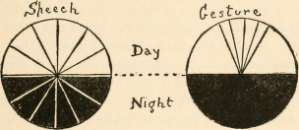
Speech therefore covers all directions night and day.
Gesture covers one-third of the circle in hours of light.
Therefore speech serves six times as many occasions as gesture.
But the chief reason for the triumph of the appeal to the ear is doubtless because the hands were in constant use for other things; the tongue was not; was indeed practically free to specialize for this end.
ITS UNIVERSALITY
Being so fundamental, ancient, and persistent, Sign Language is, perforce, universal. In some measure it is used by every race on earth to-day. Eskimo and Zulu, Japanese and Frenchman, Turk and Aztec, Greek and Patagonian. And whenever two men of hopelessly di-
verse speech have met, they have found a medium of thought exchange in the old Sign Language—the pantomimic suggestion of ideas.
Latin races are proverbially hand-talkers, so that the Sign Language is more widely used among them than with Anglo-Saxons.
But the American Plains Indian is undoubtedly the best sign-talker the world knows to-day. There are, or were, some thirty different tribes with a peculiar speech of their own, and each of these communicated with the others by use of the simple and convenient sign-talk of the plains. It is, or was, the language of Western trade and diplomacy as far back as the records go. Every traveller who visited the Buffalo Plains had need to study and practise this Western Volapuk, and all attest its simplicity, its picturesqueness, its grace, and its practical utility.
Many of the best observers among these have left us long lists of signs in use, Alexander Henry in his gossipy journal among the Mandans of the Missouri in 1806 tells us of the surprise and interest he felt in watching two Indian chiefs of different tribes who conversed freely for hours on all subjects of common interest, conveying their ideas accurately by nothing but simple gestures.
The European races are much less gifted as sign-talkers. But we all have a measure of it that is a surprise to most persons when first confronted with the facts. Our school children especially make daily use of the ancient signals.
AMONG SCHOOL CHILDREN
In taking observations among school-boys and girls, I had this uniform experience: All denied any knowledge
of the Sign Language, at first, but were themselves surprised on discovering how much of it they had in established use.
One very shy little girl—so shy that she dared not speak—furnished a good illustration:
"Do you use the Sign Language in your school?" I asked.
She shook her head.
"Do you learn any language but English?"
She nodded.
"What is the use of learning any other than English?"
She raised her right shoulder in the faintest possible shrug and at the same time turned her right palm slightly up.
"Now," was my reply, "don't you see you have answered all my three questions in signs which you said you did not use?"
Following the subject, I said: "What does this mean?" and held up my right hand with the first and second fingers crossed.
"Pax," she whispered; and then, after further trials, I learned that at least thirty signs were in daily use in that local school.
This was in England. In America the sign "Pax," or "King's cross," is called "King's X," "Fines" or "Fins" or "Fends," "Bars up" or "Truce," meaning always, "I claim immunity."
This is a very ancient sign and seems to refer to the right of sanctuary. The name "King's cross," used occasionally in England, means probably the sanctuary in the King's palace.
In general I found about 150 gesture signals in
established use among American school children, namely:
Me (Tap one's own chest).
You (Pointing to you).
Yes (Nod).
No (Shake head).
Good (Nod and clap hands).
Bad (Shake head and grimace).
Go (Pushing flat hand forward, palm forward).
Come (Drawing in flat hand, palm toward one).
Hurry (The same repeated vigorously several times).
Come for a moment (Beckon with forefinger, hand unmoved).
Stop (Flat hand held up, palm forward).
Gently (Flat hand held low, palm down, gently waved).
Good-bye (Flat hand held high, palm down and forward, fingers quickly waved up and down).
Up (Point up).
High (Flat hand, palm down, held up at arm's length).
Deep (Left flat hand palm down at level of mouth, right palm up, as low as possible).
Heaven (Point up very high and look up).
Down (Point down).
Forward (Swing index forward and down in a curve).
Backward (Jerk thumb over shoulder).
Across (Hold left hand out flat, palm down, run right index across it).
Over or Above (Hold out flat left, palm down, and above it hold ditto right).
Under (Reverse of foregoing).
Hush (Index finger on lips).
Listen (Curved hand behind ear).
Look (Flat hand over eyes).
Look there (Point and look in same direction).
Touch (Reach out and touch with index).
Taste (Lay finger on tongue).
Smell (Hold palm to nose).
Friendship (Hand shake).
Warning (Index finger held up).
Threatening (Fist held up).
Weeping (With index finger at each eye, trace course of tears).
Shame on you (Point one index at the person and draw the other along it several times in same direction).
You make me ashamed (Cover eyes and face with hands).
Mockery (Stick tongue out at person).
Disdain (Snap fingers toward person).
^Scorn (Throw an imaginary pinch of sand at person).
Insolent defiance (Thumb to nose, hand spread).
Arrogant (Indicate swelled head).
Pompous (Indicate big chest).
Incredulity (Expose white of eye with finger, as though proving "No green there").
I am no fool (Tap one side of the nose).
Joke (Rub side of nose with index).
Connivance (Winking one eye).
Puzzled (Scratch the head).
Crazy (Tap forehead with index then describe a circle with it).
Despair (Pulling the hair).
Sleepy (Put a fist in each eye).
Bellyache (Hands clasped across the belly).
Sick (A grimace and a limp dropping of the hands).
Applause (Clap hands).
Victory (Swing an imaginary flag over head).
Upon my honor (Draw a cross over heart or cross the hands over breast).
I am seeking (Looking about and pointing finger in same directions).
I am thinking (Lay index on brow, lower head and look out under brows).
I have my doubts (Slowly swing head from side to side).
I will not listen (Hold flat hands on ears).
I will not look (Cover eyes with hands).
I forget (Slowly shake head, and brush away something in air, near the forehead).
I claim exemption, or "Fins" or "Bar up" (Middle finger crossed on index).
I beg of you (Flat hand palm to palm, pointing to the person).
I pray (Clasped hands held up).
I am afraid, or surrender (Hold up both flat hands, palm forward).
I wind him around my finger (Make the action with right thumb and index around left index).
I have him under my thumb (Press firmly down with top of right thumb).
You surprise me (Flat hand on open mouth).
I send you a kiss (Kiss the finger tips of right hand and throw it forward).
Search me (Hold the coat flaps open, one in each
hand).
Swim (Strike out with flat hands).
Dive (Flat hands together, moved in a curve, forward and down).
Will you come swimming? (Two fingers in V shape held up level).
Will you? or Is it so? (Look, nod and raise brows).
Fool or Ass (A thumb in each ear, flat hands up).
Cut-throat (Draw index across throat).
Indifference (A shoulder shrug).
Ignorance (A shrug and a head shake).
Pay (Hold out closed hand, palm up, rubbing thumb and index tips together).
Jew (Flat hands waved near shoulders, palms up).
Bribe (Hold hollow hand, palm up, behind one).
It is in my pocket (Slap pocket with flat hand).
Give me my bill (Beckon, then write on air).
Match (Make the sign of striking a match on the thigh).
Set it afire (Sign match, and then thrust it forward).
Pistol (Making barrel with left index, stock and hammer with right hooked on; snapping right index from thumb).
That tastes good (Smack the lips).
The food was good (Pat the stomach).
Bad taste (Grimace and spitting out).
Bad smell (Hold the nose).
Bend (With right hand bend left index).
Break (With fists touching, make as though to bend a stick, then swing the fists apart).
Hot (Wet middle finger in mouth, reach it forward and jerk it back).
Cold (Fists near shoulder and shaken).
Paint (Use flat right as a brush to paint flat left).
Shave (Use finger or thumb on face as a razor).
Wash (Revolve hands on each other as in washing).
Knife (With right fist as though holding knife, whittle left index).
Revolver (Hold out right fist with index extended and thumb up).
Gun or shooting (Hold hands as in aiming a gun).
Drive horses (Work the two fists, side by side).
Give me (Hold out flat hand, palm up).
Write (Make the action with index).
Strike (Strike down with fist).
Fighting (Make the fists menace each other).
Drinking (Lift right hand to mouth as though it held a glass).
Smoking (Make as though holding a pipe and drawing).
Rub it out (Wet tips of right fingers, and seem to rub).
Thank you (Bow and, at the same time, swing flat right, palm up, a little way down and to one side).
Church (Hands clasped, fingers in, but index fingers up and touching).
Get up (Raise flat right, palm up, from low up high).
Sit down (Drop flat right, palm down, from high, down low).
Here (Pointing down, hand swung in small circle).*
In all, no; besides the compass points, the features of the face, the parts of the body, the numerals up to 20 or 30, and a great many half-established signs, such as
'Professor Elmer D. Read writes me that all of these are in use among the deaf also, except the signs for "shame" and "church"; for these they make the Indian signs "red" and "house prayer," respectively.
book, telephone, ring the bell, etc., which, if allowed, would bring the number up to nearly 200.
As another line of observation, I have asked New York boys, "How many signs does the Broadway policeman use in regulating the traffic?" Any bright child remembers presently that the officer seldom speaks, could scarcely be heard if he did. Indeed, he relies chiefly on Sign Language and hourly uses the established signs for "Stop," "Come on," "Come here," "Go right," "Go left," "Go back," "Hurry up," "Go easy," "I warn you," "I'll punish you," "Pass," "Keep behind me," "Scorn," and, perhaps, one or two others.
While not infrequently the small boy responds with the sign of "insolent defiance" that is used the world 'round, and was probably invented by Cain and Abel.
Similarly, the car conductor uses the signs for "Do you want this car?" "Do you want transfer?" "How many?" "Go on," as well as most of the above.
Evidently, then, the Sign Language is used of necessity in much of our life where speech is impossible.
CODES, ETC.
It is inevitable that a world-wide language be split into variant forms. Besides the fragmentary Sign Code among our children, the more copious list of signs among Latins, and the code of the Cistercian or Trappist Monks, there are the Deaf Code and the Sign Language of the American Indians. Only the two last are widely established and at all complete as languages to-day.
DEAF CODE
The Sign Language used by the deaf was originated in France by Abbe de 1'Epee about 1759, with a view to
facilitating the intercommunication of the deaf. His signs were largely arbitrary or founded on the spelling of French words, usually in abbreviated form, so that it was merely a short-hand of French done into finger-spelling.
While this was the case at its beginning, the deaf themselves had instinctively done so much in the way of introducing pantomime and expressive gesture, that they have half redeemed the Code from its unfortunate original plan, and, in so doing, have made themselves intelligible to an immensely larger audience.
THE INDIAN CODE
So far as I can learn, no student hitherto has compared the various methods without being convinced that the American Indian Sign Language is the best extant. It is theoretically perfect and practically complete. In order to make this evident, I must offer a definition and some comparative details.
A true Sign Language is an established code of logical gestures to convey ideas; and is designed as an appeal to the eye, without the assistance of sounds, grimaces, apparatus, personal contact, written or spoken language, or reference to words or letters] preferably made by using only the hands and adjoining parts of the body.
Measured by these standards, there is only one true Gesture Language in the field to-day; that is the sign-talk of the American Indians. It is established over the whole area of the Great Plains; and, though varied locally, is essentially the same from Saskatchewan to Rio Grande.
In general, it is claimed that there are two well-marked
dialects of this: the northern, which is a whole hand and a two-hand dialect; the central and southern, which is a finger and one-hand dialect.
The former is better for far signalling; the latter for conversation. There are, however, many exceptions to these rules; and, in any case, they are so close akin that Indians from opposite extremes of the Plains have no difficulty in conversing with each other.
The Cheyennes originally lived in a central region where they had intercourse with a dozen tribes whose spoken language differed from their own; so they became very expert sign-talkers, perhaps the best. They have amplified to the number of several thousand signs, and simplified until theirs has become largely a one-hand code; therefore, as far as possible, I make the Cheyenne sign-talk my standard. All signs herein given I have found in use among the southern Cheyennes and are understood to be Cheyenne except when another source is specifically mentioned.
Clark gives first place among gesture talkers to the Cheyennes and their associates the Arapahoes, whose sign-talk was the same, though their speech was very different, so that the signs for which he is authority may also be considered Cheyenne.
The signs given me as Indian by Sheeaka and his friend, Tom Frosted, should be cautiously received if one would study the ancient code. Sheeaka had in his family a deaf-mute, who probably imported some signs from the Deaf Code, as indicated.
In cases where there were different signs for the same idea, I have selected the simplest and clearest, the least
like other signs; or, other things equal, the one most extensively used, preferring a one-hand to a two-hand sign. Usually that sign is best from the locality where the idea is most familiar. Thus the Sioux sign for "tree squirrel" is poor; the Modoc sign is very good. The Navaho signs for "domestic sheep" are numerous and clearly differentiated; those of the north are not, and refer back to the "bighorn." Southern signs for "snow" are descriptive and cumbrous, while those of the northern tribes are simple and perfect.
A COMPARISON OF THE TWO CODES
A comparison of the Deaf and Indian Codes seems to emphasize the superiority of the Indian. The Deaf was intended to convey, word by word, a vocal language; it assumes that you know the other man's speech, and can spell. Whereas, the Indian was invented to over-ride linguistic barriers and, knowing nothing of spelling, deals only with ideas.
The next great advantage of Indian style is its pic-turesqueness. The two systems can be illustrated and fairly compared by the signs for the months.
First the Deaf:
January—Sign for Month, then J,N, and R, that is 4 signs.
June—Sign for Month, then / and N, that is 3 signs.
July—Sign for Month, then / and L, again 3 signs.
Whereas the Indian calls January the Snow Moon f thus moon or "Horns in the sky" and snow, that is two signs. June is Rose Moon i.e., horns or Crescent in the sky and rose (the right hand plucking an imaginary petal from each finger tip of the left). July is the
Thunder Moon, i.e., horns in the sky, then the right index darted downward in a quick zigzag to imitate lightning. All need but two signs each.
The first involving a certain amount of spelling is limited to those who can read, and who use that word. The second, touching nothing but the idea, is widely acceptable, much shorter, and visible much farther off. It was apparently developed for the safe distance beyond arrow range.
Again the Indian method is strong in its dignity. The deaf often spoil their sign-talk by grimacing, the Indian never does so. One may occasionally help the idea by facial expression, but it should be used with great reserve, as there is nothing more unlovely or likely to harm the study of the Sign Language than the excessive grimacing that one sometimes sees in an uneducated deaf-mute. The Indian sign-talker's face is calm and little changed, his head is moved in graceful sweeps, and never jerked unless to express some jerky action. His communication is indeed a study in beautiful, dignified gesture. There is not an Indian sign in this book that depends on facial expression for its usefulness, and there are but few that involve the face in any way.
Last year (1910) my friend Hamlin Garland met a party of moving picture men returning from a business tour among the Indians. He asked, "Did you get two old chiefs talking together in the Sign Language?" They said "No, hadn't heard of it."
"Then," he replied, "you have missed one of the most graceful and rewarding chances for your special art that the western country affords."
They were so much impressed with his description
that they went back. Having brought together two chiefs of diverse speech they got results on their films which amply justified their time and trouble.
Finally a large number of the signs used by the deaf are conventional and arbitrarily fixed, dating back about 100 years, whereas each Indian sign is the slow evolutionary product of ages, with its roots deep in human nature. It is never arbitrary, but so logical and so reasonable that it is easily and quickly learned.
Every interested person, therefore, must regret profoundly that the teachers of the deaf should have gone out of their way to fabricate an unnatural, localized code, when there was awaiting them ready-made, and already established, a system founded on universal human nature, old as the hills, full of the charms of grace and poetry, and so logical that any one of any race can learn it in a tithe of the time required for the acquisition of the merest smattering of a spoken language, and the adoption of which would at once have greatly lessened the handicap of the deaf. One can only suppose that the founders of the code were unaware of the other's existence.
Undoubtedly actual service has done much to reform and redeem the Deaf Code and make it more nearly a true Sign Language, but one cannot help wishing that their teachers would take the inevitable step at once and adopt the natural system.
Thus we have logic with us as well as the opinion of ethnologic students in giving preference to the Indian System. While in the extent of usage honors are about even, I am credibly assured that about 100,000 people are daily using the Deaf Code and an equal number using the Indian.
It is my belief that an available popular Manual will soon establish the latter as the universal code and result in its further and full development.
ATTITUDE TOWARD THE SIGN LANGUAGE
There are two distinct attitudes toward Indian Sign Language:
First, that of the student who sees in it a beautiful product of evolution, a perfect demonstration of the subtle laws of speech growth, the outcome of human mind yearning for converse with human mind, rebellious at its shut-in loneliness, battering with its hands the prison walls, till it could reach out and signal to the next locked-in, before it had yet found the way of modulated sounds. This, then, was the means which responded to the demand for communion and mental fellowship before there was a spoken speech. It began, as all codes must, with the broadest, simplest root ideas, and expressed their interrelationships at most by context, sequence, proximity, or emphasis, but not by inflection.
Every student of the Sign Language is impressed by this thought and very naturally considers every true sign of the old Sign Language a thing sacred, precious as a pre-Homeric manuscript. He believes that to modi-ify it or tamper with it would be to rob it of all value as a living expression of growth, and much like trying to readjust the crystalline forms on a frost-covered pane by shaping them with a hot iron. The student recognizes it as his first and highest duty to make faithful, unadulterated, untooled records of the oldest types of signs. This is the academic attitude. I am fully in sympathy with it.
Second, the practical attitude which realizes that Sign Language, never dead, is coming to its renaissance and can serve many useful ends among us here to-day. But to complete its possibilities it must be brought up to date by the addition of elements that stand for the latest modern ideas; and therefore does not hesitate to seize on and adopt these elements wherever they may be found. Thus, it may be held, is a contamination of the thought by interminglement of spurious recent creations. But it is merely submitting the code to the ordinary rules of all language. We should remember, further, that the ancient signs, as well as the modern, were invented by men who had need of them. The only difference is that the one was invented recently, the other maybe thousands of years ago; and that without such changes the Sign Language could not serve its beneficent purpose to-day among the deaf, the distant, the roar-environed, the moving picture folk, and those of unknown speech about us. Hand-talk fully developed will find much good work to do; and it matters little where the elements of the code were gathered so long as they meet with general acceptation; which implies that they be needed, serviceable, and of sound construction. The forty odd Deaf Signs included here have been admitted on this basis.
PROPER NAMES
There is at least one place where all pure Sign Language must fail; that is in dealing with proper names, especially new proper names. If I wish to signal "New York State" to an expert sign-talker, I can use the nickname "Empire State" and signal "Country great crowned"; or, for "Kentucky" I can signal "Country
blue grass"; or Boston, "The Hub City"; or Chicago "Windy City"; but when I come to South America or Oberammergau or Poughkeepsie, I am obliged to fall back on the white man's method and spell the name. For this reason then we begin our sign-talk by teaching the one-handed sign alphabet of the deaf. The two-handed will answer, but obviously a one-handed sign is better than a two-handed, other things equal. We aim at simplicity; and there are many occasions when one has but one hand free.
TO WHAT PURPOSE?
My own interest in the study had been growing for thirty years, and to satisfy myself that it was not a mere fad of slight and passing import, I set down carefully the reasons for studying and using the Sign Language, not forgetting its limitations. I set these also in hostile array and will give them first:
It is useless in the dark.
It cannot serve over the telephone.
It can scarcely be written, except by cumbrous pic-tographs.
It cannot give new proper names; they must be spelled.
But the reasons for the study were more numerous and stronger.
i st. // develops observation and accurate thinking. All races that excel in sign-talking are noted for their keenness of observation. Which is cause and which effect one cannot certainly determine, but it is sure that this method of communication is excellent practice to develop observation, and it makes for a wonderfully graphic descriptive power.
Herein, perhaps, is its most enduring, the least obvious, claim to a high place. There is a sweet reasonableness, a mathematical accuracy, in the fabric of the Sign Language that has an insistent and reactionary effect on the mental processes and pictures of those who use it. Therefore, it is valuable for the kind of mind it makes.
2d. It is easily learned. Unlike most languages, it is very easily acquired, for most of the signs are natural in concept, and so logical that they explain themselves where their history is known. Six hundred signs (that is ideas) make a fairly good sign-talker.
3d. // is Indian talk. By means of this you can talk to any Plains Indian no matter what his speech; and there are many tribes each with its own tongue or dialect. In some measure it is understood and used by savages and keen observers all over the globe.
4th. A cognate code is the talk of the deaf; and is used the world round by them in preference to the manual alphabet when possible; so that a wide use of the much better Indian Sign Language will certainly result in their accepting it and thus tend to lessen the barrier between the deaf and their more fortunate brethren.
5th. It is silent talk. It can be used on occasions when it is necessary to give information, but improper or impossible to speak aloud. Thus, lecturers use it in directing their lanternist; friends use it for necessary information during musical performances; it is used at the bedside of the sick, the actors in a moving picture can utilize it, and so be comprehended the world round; the pantomime stage, forbidden to use speech, can easily make clear the plot by sign-talk.
In a recent letter, Prof. J. S. Long has furnished me with a touching instance (one that has since recurred) that indicates another and final service that the silent method can render: An eminent divine was on his deathbed. His life had been devoted to ministering to the deaf, he knew the Sign Language perfectly; for several hours before the end his power of ordinary speech had deserted him, but his mind was clear, and to the last he conversed freely with those about him, in this, the universal talk, the one which for its exercise depended on muscular powers that in his case were the last of all to fail.
6th. // allows talk in an uproar. It can be used when great noise makes it impossible to use the voice; therefore it can be of daily service in modern life, city or country, and each year it discovers new uses. Friends talk across a rackety thoroughfare or from a moving train; firemen and policemen, or sailors in a storm find it of growing service. The baseball umpire uses it when the roar of the multitude makes him voiceless; the catcher talks to the pitcher; the aeroplanist talks to his friends on earth; the stockholder on the curb buys and sells in it; the football captain or the army officer issues clear sign orders when the uproar of fight would drown even the trumpet call. The politician facing a shrieking mob may find it useful for conveying a few crude truths to his crude, unruly audience, thus opening the way for a more usual form of harangue, or failing in the attempt, he can at least inform his friends of his next move and his audience what he thinks of them. In St. Paul's epoch-making address on the stairs of Jerusalem we have a good illustration of the first part of this.
xxxvi INTRODUCTION
7th. // is practical far-talk. It is a valuable method of talking at a distance, far beyond earshot. Compared with the other modes of far-signalling it has the great advantages of speed, for it gives a sentence while semaphore, Morse, or Myer code give a letter, and of incon-spicuousness at short range, or in a crowd; also it is independent of apparatus.
8th. It is a true universal language. It is already established. Instinctively the whole world has adopted it in a measure; and daily proofs of this are seen. Ras-mussen among the Eskimo would have been helpless, he tells us, for he knew not their tongue, and they not a word of his, but they were expert sign-talkers and the lingual barrier was swept away. So also Henry among the Man-dans, and Butler among the Basutos, while a thousand other cases could be aligned.
It is so complete that Dr. W. C. Roe and many others regularly preach and lecture in the language of Signs, to congregations in which several spoken tongues are used and would be necessary to the preacher were he limited to sounds.
It is so fundamental indeed that it is the easiest means of communicating with animals; the best trainers of dogs and horses use Sign Language as the principal medium of command.
But, for lack of standards and codification, its use is much smaller than it might be; and yet larger than commonly supposed. At least 100 of the 725 signs herein given are in daily employ among hearing white folk in America. After a little extension of the study, as is inevitable with a standard code, one will be able to travel all over Europe, the world indeed, on Sign Language alone.
No matter what the other man's language may be, French, German, Russian, Greek, all are the same in the Sign Language because it expresses ideas, not words. This, then, is its chief obvious strength—// is a universal language.
It was with this in view that the French and German equivalents were added after each sign; and since it is impossible to render in one word a sign that stands for a broad idea and is capable of conveying many meanings, according to the context and sense, the foreign equivalents are understood to deal only with the simplest root idea, that which usually is expressed by the first of the English words given.
It is my earnest hope that we may have an International Society of the Sign Language whose functions would be to keep it pure, to add new signs as they are needed, and to aim at its complete development.
Also, that in furtherance of this a thorough, full, and careful record of the old Indian Sign Language will be made before it is too late; that is, before all the old-time Indians of the Plains are dead.
My own effort is meant not as a record of the past, but a starting point for the future.
SYNTAX OF THE SIGN LANGUAGE*
The Sign Language is a system of root ideas expressed by gestures, preferably made only by the hands, without
*" After going carefully over your syntax I approve it in the main but I think it quite likely that many of the rules are not so inflexible as this makes them seem; besides which, there must be always a certain amount of modification by transliteration from the spoken language of those using the signs. This would manifest itself in a growing comformity of the Sign Language syntax to that of the more dominant spoken language." — F. W. Hodge (Ethnologist, Smithsonian Institution}.
xxxviii INTRODUCTION
sounds or reference to letters, or words, spoken or written, and not delimited by anything corresponding to words. There can be but little doubt that Sign Language preceded all audible speech.
Being fundamentally a true spontaneous language, wholly removed from any spoken language, it must necessarily have its own syntax and idiom.
Its syntax is simple and primitive, much like that of spoken language in its earliest or monosyllabic stage, as denned by Hovelacque. Yet clearly many signs are amplified by an associated but subsidiary root, so that we may consider it entering the second or agglutinative stage. Thus deer, signed by holding up the hands to indicate branching horns, is a simple or isolated root; but white-tailed deer which gives first deer, then adds the qualifying sign banner tail by waving the right index up high, is in close correspondence with agglutinative language. Still more so are the signs finished or done added to a verb to show the past tense, or the different twists to the sign give that turns it respectively into give me or give you, or the variations of talk which make it mean 7 talk to you, you talk to me, or they talk to each other.
The sentence construction is elemental. Dependent sentences are not used nor are negative or involved questions.
The relation of one idea to another is indicated chiefly by proximity and sequence, rarely by connectives and (with a few exceptions) never by inflection. So that the same sign may be the equivalent of a noun, a verb, or a phrase, etc., according as it is used.
NOUNS AND PRONOUNS
The Nominative and Objective cases are not distinguished except by context and sequence, that is, the Nominative precedes, the Objective usually follows, the verb.
A partial exception is the first personal pronoun—the starting point of most inflection—for 7, mine, and me are sometimes given as cognate but distinctive signs.
The Possessive case is usually shown by the addition of the possessive sign, equivalent to "his," "hers," "its," etc. "That man's" horse would be signed: Man, that, his horse, or Man, that there, possession, horse.
The Gender of nouns is indicated when necessary by adding the signs male or man and female or woman. Thus "A She bear" would be rendered Bear Woman.
The Number of nouns is indicated by the signs i, 2,3, 4, etc., many or few.
In the Personal Pronouns the plural is made by adding all to the singular. Thus Me all is the equivalent of "We," You all of "Ye." He all is the equivalent of "they."
The Person by pointing to myself, to you, or to the third person. The first person is understood unless otherwise
indicated.
VERBS
The Verb is usually placed between the subject and the object, but need of emphasis may change this so the verb comes last.
The Tense of verbs is marked by the auxiliary prefixes now, future and past, finished or done. Thus "I have eaten" would be 7 done eat, "I shall eat" will be 7 time ahead, eat.
The present is understood, unless otherwise stated; but the sign is plastic and may be any part of the verb, according to context. Thus Arrange, Arranged, or Arranging are the same.
The Number of the verb is shown by the context.
The Voice is assumed to be active, indeed the passive is not used.
The Imperative is shown by following the verb with the sign must, that is, strike down with right fist, giving the significance of command, or else by emphasis.
The Subjunctive is shown by the signs if, so that, perhaps.
ADJECTIVE AND ADVERB
The Adjective usually follows the substantive. Thus "A bad man" would be rendered Man bad. But numerals are exceptions to this rule.
The Adverb of time precedes the verb.
Qualities are compared by the use of the signs little, more, much, most, ahead, and behind. They are further modified by adding such signs as strong, brave, very much, or very strong.
The Numeral sign is often prefaced to small numbers to prevent confusion. Thus when prefaced by the numeral sign the sign Wolf may become two and Man become one.
Mere particles and expletives, as "a" "the," etc., have no equivalent signs.
PREPOSITIONS
Prepositions were little used by the Indian sign-talkers, though they did have above, about, across, around, at, below, beside, beyond, by, for, from, in, near, on, out, to,
under, upon, with, etc. Of or pertaining to has been added by the deaf.
CONJUNCTIONS
And or also (add on) but or if (pick out or cut ojf), so that, with are the equivalents of conjunctions. Sometimes the close continuity of two signs serves the purpose of "and," conversely a pause may indicate a full stop.
INTERROGATION
The sign of interrogation always precedes the question, but is sometimes added after it as well, for emphasis or certainty.
PERIOD OR FULL STOP
For period, the sign finished is generally used. The Blackfeet make the sign broken off and often clap the flat right down on the flat left, palm to palm, for both beginning and end of a sentence.
ABSTRACT IDEAS
Abstract ideas are not copiously rendered in signs. But it often happens that a gesture with the index alone is specific, while the same gesture with the flat hand becomes abstract. For example, compare yonder and/ar, up and up there.
OPPOSITION
The principle of opposition as pointed out by Mallery plays an important part in the pairing of signs. Thus above being fixed, below is the reverse; the sign come is reversed in go, and out reversed in in, etc.
EMPHASIS
Emphasis is sometimes given by using both hands for a sign that can be made by one, sometimes by repeating the sign, sometimes by energetic rendering, and sometimes by adding the sign very much or heap.
PARALLEL OR DUPLICATE SIGNS
Many signs are made by parallel action of both hands. Most of these are permissibly rendered by using only one hand as, woman, abandon, gratitude, etc.
ENUNCIATION OR DELIVERY
In actual and expert practice most signs are abbreviated. But the beginner, as in all new arts, should go slowly and be careful to make each sign clear-cut and complete in itself.
The hands are always held or moved so as to illustrate-as far as possible, the action in mind or its manner, or its direction, or the point where it takes place, or the shape of an object, or their relative positions if two objects are being considered.
ELEGANCE
Grace and dignity are of large importance in all good sign-talk. Ugly or vulgar gestures should be abandoned. Even angular gestures should be avoided, except to express some angular idea.
Many times my Indian teachers have said to me as I imitated their signs, "Yes, that is correct enough in a way, but it is awkward"; or "it is not graceful. We do it this way." Then they sketched the same structure,
but in sweeping lines. In this work many movements are indicated in straight lines, for the sake of simplicity. As a matter of fact, I never saw a Cheyenne make a straight-line movement, all had a graceful curve.
Many signs are followed by a changeable liaison; that is, by an introduced sweep to join it on to the sign that follows and avoid a jerk or unpleasant movement. This elegant manner is what I call an Indian accent, few whites achieve it.
In a dignified way, the expression of face and the pose were used in elucidation of the gesture, but very sparingly.
THE CONCEPT AND ITS VALUE
The student of vocal language finds vital help in remembering the derivation of words; so also the sign-talker.
Most signs were pantomimic originally, but through much use have become shortened, till now they are conventional. Yet it is well worth while in each case to note the original concept as fully as possible; first as a great help to the memory, and second as a guard against slovenly gesture and a guarantee of point, power, and structural accuracy. Some of the concepts given are evidently right, but some are mere guesses, probably wrong in many cases. It is quite permissible in any one to challenge any of them.
Nevertheless, the fact that most signs are capable of logical explanation does not mean that they are self-explanatory. Indeed nearly all have become conventional, and each must be learned separately before it can be rightly used.
Signs which make the heart the seat of the mind are,
I think, older than those which give the place of honor to the brain.
THE MANUAL ALPHABET
Although not at all Indian, it is exceedingly helpful to know the single-hand alphabet as given in the cut on page II; partly because it must sometimes be used for giving proper names and also because it saves time in describing hand positions. For example, we say "position A or B" instead of describing each hand all over again for each new sign.
THE NUMERALS
Fingers and numbers are nearly synonymous the world round when making signs, manual or written, hence the universality of the decimal system. The Indian Code, the Popular Code, and the Deaf Code are nearly alike in this, but in most points of difference the Indian is best.
To prevent mistakes in certain cases preface the number with the sign of numbers or arithmetic.
THE ORDINALS
For Ordinals, make the figure sign, i, 2, or whatever it is, then without changing the position of hand or arm, give the hand a twisting from the wrist, to add point or emphasis, meaning "number-so-and-so." This is not Indian but adopted from the Deaf, nevertheless quite logical.
ILLUSTRATIONS OF SIGN LANGUAGE
Clark gives the following (pp. 17-18) as a good illustration of the syntax of the Sign Language:
In English. "I arrived here to-day to make a treaty —my one hundred lodges are camped beyond the Black
Hills, near the Yellowstone River. You are a great chief—pity me, I am poor, my five children are sick and have nothing to eat. The snow is deep and the weather intensely cold. Perhaps God sees me. I am going. In one month I shall reach my camp."
In Signs, this literally translated would read, I—•
arrive here—to-day—to make—treaty. My—hundred
—lodge—camp—beyond—Hills—Black—n e a r—r i v e r
—called—Elk—you—chief—g r e a t—pity me—I—poor
—My—five—child—sick—food—all gone (or wiped out)
—Snow—deep—cold—brave (or strong). Perhaps—
Chief Great (or Great Mystery)—above—see—me—I
—go. Moon—die—I—arrive there—my—camp.
"An Indian in closing or terminating a talk or speech wishing to say, 'I have finished my speech or conversation,' or, 'I have nothing more to say, simply makes the sign for 'Done* or 'Finished'
THE LORD'S PRAYER
FATHER ISADORE'S VERSION
Our Father up high, medicine thy name. Thy sit-aboard down here on earth as up high. Give us all bread. Forgive our bad as we forgive bad. Lead us bad not. Ended.
Professor Elmer D. Read has supplied me with the foregoing two examples done into the Sign Language of the deaf, as below:
I—came—here—to-day—make—agreement (think parallel)—name (written). My—i C (100) tents— beyond—B-1-a-c-k H-i-1-l-s, near Y-e-1-l-o-w-s-t-o-n-e
water flow. You—most—chief, feel—tender—me. I— ragged sleeve (poor). My—five—children (sign size) —sick—nothing—eat. Snow—deep. Weather (air, wind)—very cold. Perhaps—God—look down on (see) me. I—go. In—one—month—I—shall—arrive—tents —home (eat, sleep).
The Lord's Prayer in Deaf Signs.
Our—Father—sky—into.
Honored—thy—name—truly.
Thy—kingdom—come;
Thy—law—do—on—earth—as—in—sky.
Give—us—our—bread—daily.
Forgive—us—our—lawbreaking—as—we — forgive — those—injure—us.
Lead—us—not—in-—temptation,
But—save (break our tied hands)—us—from—law-breaking.
Because—thine—kingdom, power, and—glory—forever.
Amen.
PICTURE-WRITING
As already noted, a weakness of Sign Language is the difficulty of writing it without translating it into words, and thereby changing its nature and its world-wide application. Yet it can be written; and some mention of its recorded form may fitly round out this introduction.
The characters used, because they represent ideas, not words or letters, are called ideographs or picture-writing. It is widely believed that Sign Language is the oldest of all languages, that indeed it existed among animals before man appeared on earth. It is universally accepted that the ideograph is the oldest of all writing. The Chinese writing, for instance, is merely picture-writing done with as few lines as possible.
Thus, it is said that their curious character for Hearing was once a complete picture of a person listening behind a screen, but in time it was reduced by hasty hands to a few scratches; and War, now a few spider marks, was originally a sketch of Two women in one house.
We may also record our Sign Language in picture-writing, as was the custom of many Indian tribes; and we shall find it worth while for several reasons: it is picturesque and useful for decoration; and it is likely that a pictographic inscription dug up 10,000 years from now would be read, whether our language was understood or not.*
*Since the above was written, I have come across L. F. Hadley's pictographic writing of the Sign Language, fully set forth in the bibliographical matter. E. T. S.
When the French Government set up the Obelisk of Luxor, in Paris, and wished to inscribe it for all time, they made record, not in French or Latin, but in picto-graphs.
It is, moreover, a good thing to take the young through the stages of race development; just as the young bird must run for a send-off, before it flies, so pictography, being its earliest form, is the natural first step to writing.
In this dictionary I give the written form after many of the signs that have an established pictograph. These are chiefly from Mallery, loth Annual Report Bureau of American Ethnology. A few are popularly accepted among ourselves.
NOTE
The letters, initials, etc., after the paragraphs indicate the chief authority for the sign.
Where no authority is given, it means that the sign was observed by myself among the Cheyenne Indians. Those ascribed to other Indians also were observed by myself. Besides these the following are cited:
C. Standing for Captain William Philo Clark, U. S. A.
Scott, for General Hugh L. Scott, U. S. A. Seger, for John M. Seger, of Colony, Oklahoma. R. B., for Robert Burns, the Cheyenne interpreter at Concho, Oklahoma.
Long, for Major Stephen H. Long, U. S. A.
Pop. for Popular; that is, established among ourselves.
D. for Deaf Sign, as given in J. Schuyler Long's Dictionary.
GENERAL INSTRUCTIONS
The drawing shows the hands as seen by the second person.
The digits are named: thumb, first or index finger, second or middle finger, third or ring-finger, and fourth or little finger.
The following marks, etc., are used in the illustrations:
Unless otherwise stated the solid outline indicates the position of the hands at the beginning of a sign, the dotted outlines indicate the position of the hands at the finish.
Dotted lines indicate the course of
hand employed in the sign.
Indicates the commencement point of the movement.
^Indicates the direction of movement.
Indicates the point in the gesture line at which the hand position is (x) changed.
full stop represents the termination of the move-
"A hand" means like A, and "B hand" means like B, etc., in the one-handed Deaf Alphabet (Cut i) on next page. The positions meant by "4 hand," "5 hand," "flat hand," "flat fist," or "compressed hand," are figured on the same page.
Begin by learning the Single-hand Manual alphabet as noted above.
Next learn the Numbers and the signs for Question and its combinations; also Yes and No, Good and Bad, Come and Go, Big and Small, Truth and Lie, Strong and Weak, Understand, Perhaps, Talk and Sign-talk, after this refer to the Dictionary for the signs that serve your purpose and use them according to the rules of syntax as herein set forth.
Never lose a chance of talking the Sign Language with an old Plains Indian, preferably of the Cheyenne or Arapahoe tribes. Their wonderful facility and grace are as hard to convey on paper as the pronunciation of French, and are as essential for the best style in Sign Talk. One may, indeed, know every sign in this book and not be a good sign-talker, so fundamental is this correct accent, or manner.
SIGN TALK
A Universal Signal Code, Without Apparatus, for Use in
the Army, the Navy, Camping, Hunting, Daily
SIGN TALK
OF THE AMERICAN INDIANS
BY ERNEST THOMPSON SETON
"A hand," U G hand," "flat hand" etc., mean like "A," "G," "flat," etc., on page li.
Abandon, Give It up (Thrown away, chucked). Hold both S hands, backs up, near left breast, briskly swing both down to left side, opening them with a snap and giving a slight rebound to the hands after the movement, as though emphatically throwing away something. Sometimes only one hand is used. Compare Bad, Hate, and Charge. See Divorce. Fr. abandonner; Ger. aufgeben.
Able. See Can.
Aboard (Sitting down on). Left hand out flat, palm up, right S hand on it, thumb up. Compare Sit down. Fr. a lord; Ger. an Bord.
About or Around. Hold the flat left hand pointing forward, up and to the right, encircle it several times with the right G finger. If possible, make it concrete by indicating the very thing that was encircled. Fr. autour; Ger. um . . . herum.
3


Aboard





About, in the sense oiNear by or Almost. See Close.
Above or Over (One thing above another). Bring the flat left hand, back up, in front of and a little to the left of body; left forearm horizontal, fingers pointing to right and front; bring the flat right hand, back up over the left in a semi-circle upward large or small, as best suggests the actual distance. Has been used for More than. Compare Beyond.
Fr. au-dessus; Ger. iiber.
(Below is the reverse of this.) Absent. See Empty.
Abuse to Scold or Defame (Throwing lies against one). Hold the right V hand near the mouth, pointing to left. Jerk it forward toward person once or twice. For Abusing me make the sign lower opposite the left breast and inward toward one's self.
Fr. calomnier, injurier; Ger. schmahen, beschimpfen.
Accident. See Free, also Luck.
Ache or Pain. Thrust G finger many times in different directions over and parallel to the part. Compare Wound and Sick.
Fr. la douleur; Ger. der Schmerz.
Across, Cross, or Over (Crossing a ridge). Hold the flat left hand out, palm down, and pointing forward and toward the right, pass the flat right hand edgewise across the back of the left. If but one person is meant,
the right G is sometimes used. This sign as illustrated is often used for Council. See Council and Laws. Fr. d'un cote a I'autre, traverser; Ger. hinilber.
Act, as in a theatre play. Hold A hands in front perpendicularly, move up and down alternately as though the thumbs were two puppets. (Deaf sign, not used or understood by Indians.) Compare Play and Follow.
Act, as in a play. Sign Face, Two, Dance (that is dancing with a mask) (not established). Yr.jouer; Ger. spielen.
Act or Deed. See Work.
Add to (Piling up). Flat left hand pointing to the right and front, palm up, forearm horizontal; the palm of flat right hand is placed on top of left hand a number of times, the left hand being raised a couple of inches each time, to meet it; the movement ends with left hand as high as top of the head. Often it is done as in the illustration but with palm of left down.
Adjectives, see Comparative.
Adulation. Kissing the back of the hand. (Pop.) Not Indian, but they understand it now. (R. B.) Fr. la flatterie; Ger. die Schmeichelei.
Advance. Both flat hands back up, pointing forward, tandem, right in advance, six inches ahead (the fingers extended) moved forward together in gentle jerks. Compare Move camp.
Fr. avancer; Ger. wrsckreiten.



SIGN TALK



Afraid

-, After
Advance Guard (The one ahead, looking). Flat left hand back up, pointing forward, breast high; place G right just before it, then turn right G into V to mean Looking. Also used for Scout. Compare Ahead. Fr. I'avant-garde; Ger. die Vorhut.
Advise or Advice. Sign Talk, Make, Way. (C) Sign Help and Talk would be near it. Fr. conseiller; Ger. raten.
Afraid (Shaking heart). Sign Heart then shake it up and down two or three times, to indicate the throbbing action of the heart under influence of fear. Or more strongly, sign Heart and then finish by raising the hand until its back strikes the chin, to mean the heart rises in the throat.
Fr. effraye; Ger. angstlich.
Afraid or Cowardly (Seger says this means Buffalo backing out of fight; that is, " drawing in his horns." ) Hold out both G hands level, backs out, G fingers hooked like horns, draw them straight back together for six inches. Mostly but one hand is used. Compare Bring. Fr. Idche, poltron; Ger. feige.
Afraid of no one. Point right G in several directions, then add Afraid, Not.
Fr. peur de personne; Ger. vor niemand Angst haben.
After, Behind, or Late (Time or space). G fingers pointing forward at an angle in front of body; left in advance. Draw the right over and behind the left. Draw it back a little way for a little bit after; but far back and low
SIGN TALK
down for a long way behind. Some finish by clenching ••he right hand.
JL t meant that one is behind the rest, use the flat left hand, palm down, in advance, with right G behind. Fr. apres; Ger. hinter, nach.
Afternoon. Make a circle of right thumb and index and sweep it over the afternoon half of the sky from the zenith down. Compare Sunset.
Fr. Vapres-midi; Ger. der Nachmittag.
Again. See Repeat or More.
Against, i.e., Go Against. Thrust the tips of the flat right, back out, square against the palm of the flat left held pointing level forward, back to left. See also Oppose. Compare Quandary. Fr. contre; Ger. wider.
Agent, Indian. Sign Whiteman and Chief, Give all. The Southern Cheyennes sign Chief and pull teeth, because their first agent had false upper teeth.
»
Agitate. See Excite.
Agree. Sign You, I, think, same. Sometimes use Equal. See also Treaty.
Fr. s'accorder; Ger. iibereinstimmen.
Agreement. See Treaty.
Ago, Time back, Past, or Back. Sign Time and point back over the right shoulder with right finger G. Some-

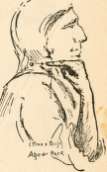
SIGN TALK


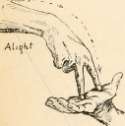

Alice-
times the thumb or the whole hand is used instead of the index. See Back.
Fr. passe, il y a quelque temps; Ger. writer, jruhfr.
Ahead or Before (In time). Hold out the left G pointing forward and up; swing the right G over the left to a place in front of it, both pointing the same way. Some finish by closing and lowering the right fist. Compare After.
Fr. avant; Ger. vor.
Ahead or Before others (In space or rank). Hold out flat left, back up, near breast, pointing forward and slightly upward; then hold right G just before it. Compare Advance Guard, which it exactly resembles, except that this omits Looking. Fr. en avant; Ger. vor.
Air. See Wind.
Alight or Descend. Indicate from what, then drop right V fingers downward onto flat left palm. See Dismount. Fr. descendre; Ger. absteigen, hinuntersteigen.
Alike, to Look like or Resemble (Of persons). Make the signs Face and Equal.
Fr. semblable; Ger. dhnlich sein.
Alive, Live, Life, or All right (Walking about, upright). Hold index of right hand upright, move it about shoulder high, forward in long slow zigzags sidewise, always turning it so as to move palm forward. Also used for Be or Exist. See Life, Deer, and Nothing. The Black-feet use the sign Grow for this idea. See Wandering. Fr. vivant; Ger. lebendig.
All.' fWith right hand flat and back up, describe a large horizontal circle, shoulder high. s
Fr. tout; Ger. alles.
All gone or Empty (Hands swept clean). Both 5 hands in front of body, backs out, right nearer; loosely brush fingers of right on left palm, moving right outward, then reverse and repeat. Sometimes begin with sign All. See Wipe out. Fr. vide; Ger. leer.
Alliance or Friendship (Linked together). Form two
.iffy'
circles with thumbs and index fingers, and link them to- -r^-gether, other fingers closed. Some use only index fingers hooked together.
Fr. I'alliance; Ger. das Bundnis.
All right. See Good or sometimes Alive.
All the time. Hold up the left G, pointing upward, forward, and to the right; strike on it with right G near the tip, then every inch or so up to the arm. See Many times, Cheyenne and Buy.
Fr. toujours; Ger. immerzu.
Alone or Only (Living and moving singly). Move the right G hand, pointed upward, slowly forward and to left in a line slightly waving to right and left. Compare Alive, Life, Man, One and Up there. Fr. seul; Ger. allein.
Already. See Now.


AH .0


All 1he Time-
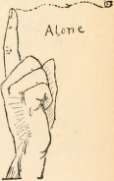
SIGN TALK

^
•;;•
/? Always, Ever, or Forever (Going on in cycles). With
"j\i\ / f'\ elbow at side, hold the right G hand pointing forward;
* ^ p i* / *3
'' J H/ X move hand forward, describing circles with the index, the result a spiral, ending with the index raised. (Frosted, borrowed from the Deaf Code.)
Always. Sign Long time, Wiped out, and Not. Sometimes sign Stop, Not. (Blackfoot signs.) See All the time.
Fr. toujours; Ger. immer.
Ambitious (Pushing to rise). Indicate a person, then sign Push and Rising man, or omit last. Fr. ambitieux; Ger. ehrgeizig.
American. See Nationalities.
Ammunition (Cartridges in belt). Lay the flat hands, palm in, on belt, then add Shoot by shooting the right G forward. (Not Cheyenne, but understood.) Fr. les munitions; Ger. die Munition.
Among. Hold the left 5 hand in front of neck, pointing upward, move right G index (pointing down) in and through. Sometimes use With. Fr. parmi; Ger. unter.
Ancestor. Repeat the sign for Father several times, with the flat left hand held back out on the breast, and each time pushed farther away, the Father sign made beyond it. (Crow sign.) The Cheyennes sign Father and Old.
Fr. I'ancetre; Ger. der Vorvater.

SIGN TALK
11
And or Also (Meet and go together). The spread flat right hand, breast high, back forward, drawn six inches to the right and closed to flat hand. (Deaf sign.) Compare Horse. The Cheyennes use Equal or Increase, according to the sense; or sometimes With or Add. Fr. et, atissi; Ger. und, auch.
Angry (Mind twisted). Twist the A hand against or near the forehead.
Seger maintains that this means a " mad buffalo breaking off his own horns." Possibly he is right; for the older signs make the heart, not the head, the place of the mind, and this must be a very old sign. Some of the Blackfeet make this sign over the heart. Some grind on the heart with the flat right fist, palm in, after pointing to the person; meaning, "he grinds my 'heart." See Sorrow.
Fr. en colere; Ger. bose, zornig.
Animal or Quadruped (Jumper). The compressed right hand, back up, advanced in short jumps, as in Frog and Weasel. Sometimes the sign Ground is made first by sweeping the flat right across, palm up. " Leaping >: is generic for the quadruped as " Flying" is generic for Bird. Compare Jump. Used by Blackfeet. The Cheyennes considered it incomplete. Fr. Vanimal; Ger. das Tier.
Annihilate. See Exterminate or Wipe out. Annoyance. See Trouble.
* - e>

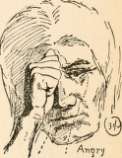
AT,
ory

Annul. See Rub it out.
SIGN TALK
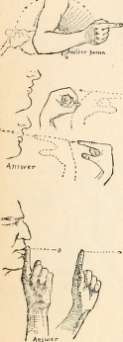

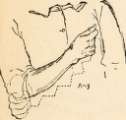
Another or Other (one other). Hold out flat right, back up, swing it slowly up, out, far to right and down low, turning it palm up. Compare Fall and Lie down. Fr. un autre; Ger. em anderer.
:;::• Another person. As above, but use right G. (Black-foot.) In this, as usual, the index up alone means Man. This gesture is so natural that many whites use it; as, for example, in saying impatiently: " That was another man altogether."
Answer (Talk come back). Push right G from the mouth in the sign Talk, then draw back reversed; that is, pointing to one's own face or ear. (Blackfoot.) The Cheyennes use Talk, Arrived here.
Answer, Reply, Respond (The word that follows the other). Right G index upright on lips, left six inches ahead and parallel; move them together toward the person. (Frosted, borrowed from the Deaf Code.) Fr. la reponse; Ger. die Ant-wort.
Antelope (Pronged horns of the animal). Bring the L hands palm toward and alongside of the head, near the base of the ears.
Fr. rantelope; Ger. die Antilope.
Anxious. See Want.
Any (Scattering). Place the right A hand near left side, elbow high; draw it down and out to right side in a shaky curve. (Deaf sign.) Use Here and There. (Cheyennes.)
Fr. quelconque, quelque; Ger. irgend ein.
SIGN TALK
13
Apache. See Indian.
Appear, To come into view. See Come into mew.
Appears, Seems, or Looks like (See and Same). Hold up flat right hand, thumb toward self, shoulder high; throw it forward and turn palm toward self, fixing the eyes on it and sign Same. Sometimes use the sign for Look before Same. (Frosted; probably adopted from Deaf Code.)
Fr. paraitre; Ger. aussehen, erscheinen.
Applause. See Approval.
Approach or Moving toward. Hold partly bent left hand well in front, breast high, to left side, palm to you and right similarly to right, but quite near to you; move the latter slowly forward toward former, but not to touch it by several inches. Some use right G. See Arrive there and Quandary.
Fr. approcher; Ger. naher kommen.
Approval, Applause, or Praise. Make the motion of clapping the hands, but without noise. A white man's sign, but now generally understood. Fr. Vapprobation; Ger. der Beifall.
Arise or Get up. Hold out right G, back down; raise the arm with a swing and snap and bend the wrist till the finger points straight up. For a large number, use both 5 hands.
Fr. se lever; Ger. aufstehen.
Arithmetic. See Numeral.
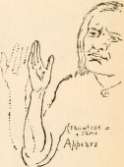

jY \

SIGN TALK
If
.'* "
Vi
;/'
<f
4
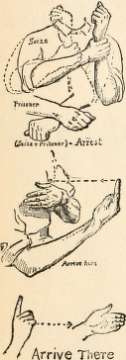
Arrive There
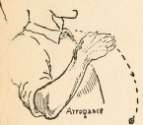
Around. See About.
Arrange (Parfleches placed in teepee). With flat right, slightly curved, back out, strike half a dozen times in a circle, turning to watch the hand; then add Good. Sometimes omit Good. Or, sign Work and Fix. See Ready.
Fr. arranger; Ger. ordnen, einrichten.
Arrest or Imprison (To seize hold of and tie at wrists). ^\ Sign Seize and then add Prisoner; that is, cross the wrists, hands closed. Sometimes the upright left forearm with S hand, back to left, is held near the left shoulder, grasp left wrist with right hand and pull it a little distance to right.
Fr. arreter; Ger. verhaften.
Arrive here or Get here. Hold the flat left hand, back out, near the breast, fingers pointing to right; carry right G, back to front, well out in front of body; bring the right hand briskly against back of left. Often the flat right is used instead of right G. Fr. arriver id; Ger. hier ankommen.
Arrive there or Reach. Hold the flat left hand, back to front, well out in front of body, about height of neck, pointing to right; bring right G hand, palm outward, in front of and close to neck, carry the right hand out sharply to strike the palm of the left. Fr. y arriver; Ger. hinkommen.
Arrogance. A haughty lifting of the eyebrows and sidelong, disdainful look down as upon an inferior. (Scott.)
SIGN TALK
15
Sign Head, Big. In the popular code, indicate big chest. See Conceit and Pride.
Fr. Varrogance; Ger. die Anmaszung.
Arrow. Make, with a long swing, the motion of drawing an arrow from the left hand. Fr. lafleche; Ger. der Pfeil.
As or Than. Both hands, G fingers parallel, level, forward near right side; carry them over to left in similar position. (A sign borrowed from the Deaf, Frosted.) This is the same as Who; only the context can show which is meant. Sign Same or Beside. Fr. comme, que; Ger. wie, als.
Ascend. Indicate the object (hill, tree, etc.), then press right G against it, raising the same in jerks. Compare Famous.
Fr. monter; Ger. hinaufsteigen.
Ashamed or Bashful (Drawing blanket over face). Flat hands pointing up, palms in, close to face and moved in till the wrists crossed, right nearest the face; bow the head a little. Compare Blind and Dark. The bowing of the head was not generally done, yet is f the only feature to distinguish it from Dark. Fr. honteux; Ger. verschamt, verlegen.
Ashamed (I am ashamed). Cover the face and eyes with both hands. (Pop.)
Fr. avoir honte; Ger. sich schdmen.
\

f • x
%T
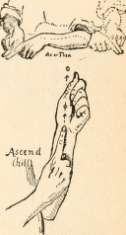
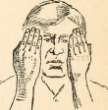
\Ashtmtd.

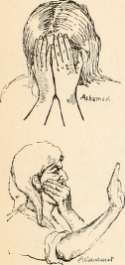

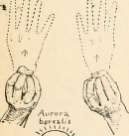
Ashamed (You should be). See Shame.
Ashes. Sign Fire and Powder. Fr. la cendre; Ger. die Asche.
Ask. See
Assiniboine. See Indian.
Astonishment or Wonder. Lay the flat palm of left hand over the open mouth and draw the body backward. Sometimes, also, raise right hand flat, palm forward.
Fr. Vetonnement; Ger. die V erivunderung.
Astray. See Lost. Astride. See Horseman.
At. Hold left flat hand, back up, pointing partly up; strike the back with right flat hand. Fr. a; Ger. an, auf.
Attempt. See Try.
Attention (A command). See Call.
Aunt. Sign Father (or Mother} and Sister. Or, sign Woman with right, then tuck compressed right, point down, under left arm pit. (R. B.) Fr. la tante; Ger. die Tante.
Aurora or Northern Lights. Both hands, backs down,
SIGN TALK
17
half closed, thumb and finger tips together, raised very high and spread with a sweep to indicate flashes. It should be done facing north. It is helped if the hands when at the highest are swung apart in an arch. Fr. Vaurore boreale; Ger. das Nordlicht.
Automobile. See Motor car.
Autumn (Leaf-falling time). Make the sign for Tree with both hands, then for Leaf with the right near the left finger tips, then drop the leaf with tremulous, wavy j motion down and to right.
Fr. Vautomne; Ger. der Herbst.
Avoid or Miss. Hold up G hands, move them toward each other as in Meet, but carry left well outside, past and beyond without meeting. Compare Meet, Trade, and Mistake.
Fr. eviter; Ger. vermeiden.
Awl. Bore right G finger into left palm. Or, over the left G as in sewing.
Fr. VaUne; Ger. die Ahle.
Axe or Hatchet. Hold out the flat right hand, back to right, wrist bent downward. Make as though chopping with it; that is, strike down once or twice. Some also grasp it near the elbow with left index and thumb, but the Cheyennes omit this. For Hatchet, indicate Size. See Tomahawk.
Fr. la hache; Ger. das Beil.


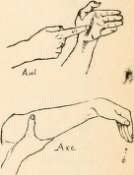
SIGN TALK B

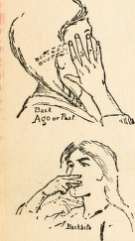
Baby. Swing the flat right hand (sometimes S hand) in the hollow of the left arm as though it were a baby. Add signs for sex and size when needed. Compare Tomahawk.
Fr. le bebe; Ger. das Kindchen, der Sdugling.
Bachelor. Sign Man, Marriage, No. (C) Fr. le celibataire; Ger. der Junggeselle.
Back or Again. See Repeat.
Back, Backward, Ago, or Past (In time or space). Throw right 5 hand thumb first back over right shoulder once or twice. See A go.
Fr. en arriere; Ger. hinten, zuruck.
Backbite. Lay the right V hand on the mouth, as in Lie, then lay it on the back of the right shoulder. (Blackfoot.)
1
Backbite. Sign Scold, Talk, and Hide. Fr. medire de; Ger. verleumden.
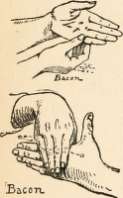
Bacon (Meat and thin). Hold out the flat left hand, thumb edge up; with thumb and finger tips of right back down, rub little finger of left. Hadley gives this with the right hand over. It makes a better sign, but I never saw it used that way. Compare Meat and Thin and Oil.
Fr. le lard; Ger. der Speck.
Bacon.
SIGN TALK
19
Bad or Evil (Suddenly thrown away). Hold clenched fist, back up, near breast; throw it forward, down, and aside, opening the hand. Sometimes for emphasis both hands are used. Compare Abandon, Charge, and Hate.
Fr. mauvais; Ger. schlecht.
Badger (Walks under ground). Sign Hole, Enter, and Walk. The Blackfeet sign is Striped-face with size and pawing indicated.
Fr. le blaireau; Ger. der Dachs.
Bad Taste. See Taste Bad.
Left C hand, back out; drop compressed right into this; then sometimes indicate thickness with flat hands pointing straight up.
Fr. le sac; Ger. der Sack.
Bald. Lay the flat right hand on the forehead, draw it up and back to the top of the head. Touch the hair and sign Wiped-out. (Blackfoot.) Fr. chauve; Ger. kahlkopfig.
Band or Patrol (Banded together). Hold the compressed left hand pointing up; encircle it with the right forefinger and thumb. (Chasing Bear.) Not a true Indian sign and not used, but would understand it. (Seger.) Sometimes use Bunch or Few. See Tribe or Troop.
Fr. la bande, la patrouille; Ger. die Schar, die Truppe.
Bankrupt. See Done.
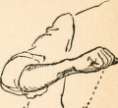
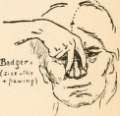
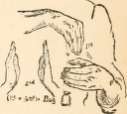

B2LTI A

Bar or Saloon (House of drink). Sign Crazy, Drink, House.
Fr. le cabaret, la buvette; Ger. die Bierstube, die Kneipe.
Bark (Like a dog). Sign Talk, but use index and middle finger against thumb.
Fr. aboyer; Ger. bellen.
Barracks. Sign White, Soldier, House. Fr. la caserne; Ger. die Kaserne.
Barren. Sign Born and All gone. Fr. sterile; Ger. unfruchtbar.
Bar up. See Fins.
Baseball signs. These, of course, are not Indian; they differ locally, but the three following are used by most umpires:
A strike. The sign "Yes."
Out. The Same as the "No" sign (as tho striking something to one side with the back of hand).
Safe. Hand raised as in "Easy."
Bashful. See Ashamed.
Basin or Hollow (A spread out circle). Hold the L hands low in front, backs up, forming an incomplete horizontal circle, not touching, the index fingers nearer each other than thumbs; swing the hands apart by wrist action so the index fingers point nearly forward. Fr. le bassin; Ger. die Vertiefung, die Grube.
SIGN TALK
21
Basket. Sign Kettle, then interlock fingers as in House of logs, to show structure. The Cheyennes understand this, though usually they sign Kettle and Sew.
Basket. Lock the fingers of the hollowed hands, backs down, join the thumbs as for a handle, then with the right hand grasp left thumb and raise the hand a few inches. (Sioux.) Compare Corral. Fr. le panier; Ger. der Korb.
Bat. Sign Night and zigzag flight; i. e., flat hands side by side, breast high, flapped first to right side next to left. (C)
Fr. la chauve-souris; Ger. die Fledermaus.
Battle, Combat. Sign Fight, after which make Shoot with each hand toward the other. (C) Compare Fight and Kill.
Fr. la bataille, le combat; Ger. die Schlacht.
Battle-cry or War-cry. Open the mouth as in saying "0" and pat it with flattened fingers of right hand. (C) The Cheyennes use Yell.
Fr. le cri de bataille; Ger. der Schlachtruf.
Bay. Sign Water, then bring right L hand well out in front of body, forming a horizontal half-circle. (C) Fr. la baie; Ger. die Bucht.
Bayonet. Sign Gun, then lay left G index alongside right G, the latter one-third ahead. If there is doubt, indicate drawing it on the barrel tip. Fr. la baionnette; Ger. das Bajonett.,


^'
>V"? ^
ffr'{^*^)&JBM/ter
':'•;. W;.£*\ J'"'.;v''"
Y,->." .*£» -' <•

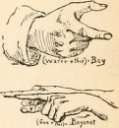
SIGN TALK
£~
:
i


'J3ea<*t

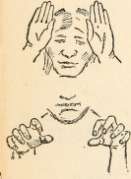
EATS r v
Be, to be or exist (Living). Sign Alive and then finish with Now or Past to indicate tense, and Many to /.-.• indicate plural. Sometimes use Dwell or Recover for
'••") this idea. Compare Alone.
/ Fr. etre; Ger. existieren, sein.
Beads. Hold out the flat right, slightly hollow; drop it a little with a sidewise quivering to suggest the shimmering of a handful of beads. (C)
Beads. Simulate holding beads between the left index and thumb, while threading them with a needle in the right. For Beadwork add a design or sign for Work. Fr. les perles; Ger. die Perlen.
Beans (One picked out of a handful). Right hand flat, palm up, index and thumb joined with the tip of index projecting. (Chasing Bear. Understood by Chey-ennes.)
Fr. les haricots; Ger. die Bohnen.
Bear. Hold out the Y hands, backs up, and strike both down; push both forward in a series of jerks, or swing down, forward and up.
Bear. Hold up flat fists near ears, palms forward, to indicate round ears. (Blackfoot.) Some indicate the paws by holding up both curved 5 hands. Fr. I'ours; Ger. der Bar.
Bear, Grizzly. As above, but indicate the gray color. Fr. I'ours gris; Ger. der graue Bar.
SIGN TALK
23
Beard. Hang the compressed right hand, point down, under chin. The hand or hands are differently placed for different cuts of whiskers. Fr. la barbe; Ger. der Bart.
Beat, or Overcome. Use Kill.
Beautiful, Handsome, or Pretty. Hold up flat right hand, and look on the palm as in a mirror, then make the sign Good.
Beautiful. Draw the flat hand down near the face, back forward, and sign Good. Fr. beau; Ger. schon.
Beaver (Tail of beaver striking mud or water). Hold left flat hand in front of body, left arm horizontal; strike up against the left palm once or twice with back of right flat hand.
Fr. le castor; Ger. der Biber.
Because. Sign Consider, then Behold. Understood by Cheyennes and Blackfeet, though not well established. Fr. parce que; Ger. weil.
Become orTurninto. SignGrow and Same or Arrive there. Fr. devenir; Ger. werden.
Bed (Spreading blanket for sleep). Hold flat hands palms up, points forward, one behind the other, left ahead, push it forward, at same time draw back right, then add Sleep.
Fr. le lit; Ger. das Belt.

T.,< \ £«*"«
%b
-of
SIGN TALK


Bee. Sign Fly, Arrow, and One. (C) In Cheyenne, sign Small, Bird, Make, Taste. Fr. Vdbeille; Ger. die Biene.
Before. See Ahead.
Before, that is, Future. Sign for Time, but hold left hand near breast and swing right forward, up and over. Or sign After, Many Sleeps. Fr. avant; Ger. ehe.
Beg (To ask alms). Hold out the flat right hand, palm up, as a beggar does. Swing it forward and upward, then draw it toward self, slightly curving the fingers. Fr. mendier; Ger. betteln.
Beg, I beg of you, Ask, I pray you. Lay the flat hands together, palms touching, fingers pointing up (or clasp them) and hold them toward the person. A white sign now understood by the Indians. Compare Pray. Fr. supplier; Ger. bitten.
Begin, Commence, Must, Push, Try, Go ahead (Start in a race). With elbow at sides and arms level, push fists forward two or three inches, right a little behind. Or use Go. See Strong.
Fr. commencer; Ger. anfangen, beginnen.
Behavior. See Way.
Behind. See After.
Behold. Hold out flat right, palm up, pointing forward
and moved slowly down to below level, use both hands. Compare Show. Fr. regardez!; Ger. siehe da/
Sometimes
SIGN TALK
25
Believe. Sign Think, Straight. Fr. croire; Ger. glauben.
Belonging to. See Possession.
Below, Beneath, or Under. Is the reverse of Above; which see.
Fr. dessous, sous; Ger. unter.
Belt. With both hands, make as though putting on a belt.
Fr. la ceinture; Ger. der Giirtel.
Beneath. See Below.
Bend or Bent. Take left index in right finger and thumb and bend the middle joint of it at right angles. Or sign Break very slowly.
Fr. plier; Ger. biegen.
Berry. With right middle finger and thumb hold tip of right index, letting it project a little; add Bushes. Or, sign Tree, Pick, and Eat. This is a descriptive phrase rather than an established sign, but it is a good illustration of impromptu constructions which are continually made and are at once understood because in harmony with the main principles of Sign Talk. Compare Fruit, Cherry, and Bullet. Fr. la baie; Ger. die Beere.
Beside or By (By the side of). Like With, but right G about three inches off left palm. Sometimes use Close. Fr. a cote de, pres de; Ger. neben.

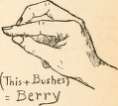

SIGN TALK

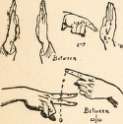

Bet or Wager (Placing on each of two piles). Indicate the event, as Race, then sign Place; that is, hold out partly compressed hands backs up; swing both forward up and down nearly together at finish. Fr. le pari; Ger. die Wette.
Between. Hold up the flat hands, palm to palm, six t// inches apart; then thrust the right G on line close past * °> left palm.
Between. Hold left V hand, fingers level, pointing to right (or straight up) and drop right G down between. Fr. entre; Ger. zwiscken.
Beware, Caution, or Look out. See Warning.
Beyond or Other side. Hold the flat left hand, back up, in front of body about ten inches, fingers pointing to right; bring flat right hand, back up, between left and body at same height, fingers pointing to left; swing the right hand upward, outward, and then downward on curve, beyond left hand, turning right hand back down in movement. Compare Fall and Other. Fr. au-dela de; Ger. jenseits.
Bible. Sign Book and Medicine. Fr. la Bible; Ger. die Bibel.
Big. Hold the curved 5 hands with palms toward each other, well out in front of the body, hands a little lower than shoulders and a few inches apart, pointing forward; separate hands, carrying right to right, left to left, keeping them opposite each other. Also used for Long. Compare Great and Long. Fr. grand, gros; Ger. grosz.
SIGN TALK Bighorn. See Sheep.
27
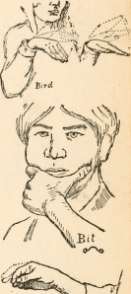
Bird. With flat hands at the shoulders, palms down, imitate the motion of wings. Using different speeds for different birds. Compare Fly, which progresses. Fr. Voiseau; Ger. der Vogel.
Birth. See Born. Bison. See Buffalo.
Bit (Of a bridle). Place the L hand palm down on the mouth.
Fr. le frein; Ger. das Gebisz.
Bite. Bring the right C hand, back outward and upward, a little in front of the body; snap sharply together the tips of the first and second fingers and the tip of thumb against the back of the left flat hand, repeating the motion. Some omit left hand. The Blackfeet make Bl ' ft ^jf /
this from the mouth.
Fr. mordre; Ger. beiszen.
Bitter or Sour. Touch tongue with tip of right G and add Bad. Compare Salt, Sugar, Taste, Taste bad. Fr. amer; Ger. bitter.
Black. See Color. Blackfoot. See Indian.
Blackguarding or Reviling (Lies from both). Hold up right V, pointing nearly level forward, opposite right shoulder; left ditto at left shoulder; swing them alternately at each other.
Fr. outrager, insulter; Ger.jemanden beschimpfen.
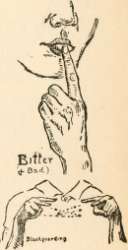
SIGN TALK

•/B.'AV.V,/ \ ' !
a

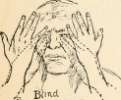

Blanket or Robe (Wrapping about shoulder). Bring the A hands palms toward each other, opposite and above each shoulder near the neck; move the right hand to left and left to right till the wrists are crossed, right hand nearest body. Compare Fond, Fr. la couverture; Ger. die Decke.
Bless you (Drawing from above and spreading out). Hold the flat hands high up in front, palms forward, apart, at arm's length. Lower them a little and slightly push toward the person meant. (C)
Fr. que Dieu vous benisse; Ger. Gott segne dich!
Blessing the food. Hold both 5 hands over the food, then add Talk upward.
Blind. Bring both flat hands, backs outward, in front of and close to eyes, right hand nearest and both hands parallel to face; move right hand slightly to left, left to right; then place the tips of the fingers against closed eyes. (C)
Fr. aveugle; Ger. blind.
Blood (A wounded buffalo bleeds at the nostrils). Raise the right V hand so the tips of the fingers are pressed one against each nostril; move the hand to the right and downward, giving it a tremulous motion. Add Red. Some omit Red.
Fr. le sang; Ger. das Blut.
Bloom or Blossom. See Flower.
Bluff. See Hill.
SIGN TALK
29
Boat. Bring the hands together hollowed, fingers straight, little fingers joining, the thumbs somewhat apart, to represent the body of a boat, held before the breast. Push it forward to indicate movement. Add the motion of paddling for Canoe, or Rowing for bigger boat. Usually the Boat sign is omitted; Paddling or Rowing being enough by itself. Compare Bowl. Fr. le bateau; Ger. der Kahn.
Boil. See Cook.
Fr. bouillir; Ger. kochen.
Bone. Hold up the left hand, palm down, wrist a little bent; with right G tap the wrist bone on outer side of left; then add Hard.
Fr. I'os; Ger. der Knochen.
Bonnet, that is, Warbonnet. Sweep 5 hands along near each side of head from front to back. Sometimes also sweep right 5 hand down behind for the Tail. Fr. le bonnet de guerre; Ger. die Federkappe.
Book. Open and close the flat hands like cover of a book, then indicate the lines of writing. Sometimes show the thickness to distinguish it from Letter. Compare Open and Shut.
Fr. le lime; Ger. das Buck.
Born, Birth, or Parturition (Issuing from loins). Flat right in front of and near the body, pointing downward / and to front, moved downward and outward on a curve.
( -*o v
Compare Dive.
Fr. ne; Ger. geboren.
Borrow. See Lend.

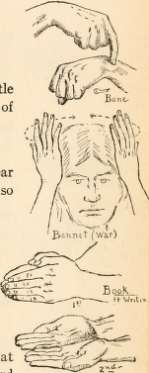
\

SIGN TALK
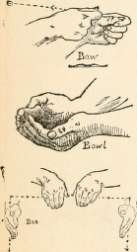
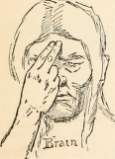
Boss. Use Chief.
Both. Sign Or, that is, hold up the left V, pointing forward, and tap each tip of V, and in turn, with right G; then over left V add All with right. Sometimes point to each and add Two. Sometimes use All. Blackfeet use Two and Same.
Fr. torn les deux; Ger. beide.
Bow (Weapon). The left A hand held still, a little advanced, the right A hand touches it and makes the motion of drawing the cord of the bow. Fr. rare; Ger. der Schiessbogen.
Bowl (A vessel). With curved hands side by side, lingers bent, palms up, indicate shape. (C) Compare Boat. For a larger vessel, use Basin.
Fr. le bol; Ger. die Schale, die Schiissel.
Box. Hold out both flat hands side by side, backs up; then swing apart and down at right angles, turning the hands at the angle so the backs are out. Fr. la boite; Ger. der Kasten.
Boy. Sign Man, Young.
Fr. le garqon; Ger. der Knabe.
Brag. See Bravado.
Brain. Touch forehead with N hand. Fr. le cerveau; Ger. das Gehirn.
Brand or Name. All ringers of right closed but thumb and index, these form a "C," which lay on the palm of
SIGN TALK
31
flat left, pointing forward, thumb up. Sometimes lay it on left shoulder outside. Compare Name.
Fr. la marque, marquer avec un fer rouge; Ger. das Zeichen, das Brandmal, einbrennen.
Bravado or Brag. Sign Fire, Talk, True, and No. (C) Fr. la bravade; Ger. die Prahlerei.
Brave (Strong heart). Sign Heart and Strong. Fr. brave; Ger. mutig, tapfer.
Brave, as an intensive. See Very much.
Bread (Making a cake). Gently clap the slightly hollow right hand over slightly hollow left hand, then reverse so left is on right and clap them together again; repeat.
Fr. le pain; Ger. das Brot.
Break. Make the motion of seizing a stick, hold it horizontally with both hands and breaking it in the middle. The thumbs finish wide apart. Fr. casser, briser; Ger. zerbrechen.
Breakfast. Sign Sunrise and Eat.
Fr. le dejeuner; Ger. das Fruhstiick.
Breeze. See Wind.
Bribe. Hold the hand behind the back, hollowed, open and palm up. (Pop.)
Fr. corrompre; Ger. bestechen.
Bridge (Lifting over water). Sign Water; hold out the
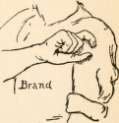


r«M>
32
SIGN TALK




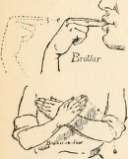
flat hands horizontally in front of body, pointing forward, palms up; and Across. Fr. le pont; Ger! die Briicke.
Bridle. Like Bit; but raise the hand till near the eyes. Fr. la bride; Ger. der Zaum.
Bring, Take, or Fetch. Move the right G hand briskly well in front or to right or left of body; draw the hand with a sweep in toward the body, at the same time curving index finger. Compare Come in which the index is held vertically, and Steal.
Fr. apporter, prendre; Ger. bringen, nekmen, holen.
Broad or Wide. Same as Big, but keep the hands flat and palms up.
Broad and Spreading is the same as above but with palms down. Compare Prairie. Fr. large; Ger. breit.
Broke or Dead broke. See Done (No.2.) Broken down. See Decrepit. Brook. See Creek.
Brother (Suck together). Lay nearly horizontal N of right hand on lips; draw it away and down, then add Male.
Fr. le frere; Ger. der Bruder.
Brother-in-Law. Left forearm across breast; with lower edge of flat right, strike down past left elbow. Probably means relative on the side. (R. B.) Fr. le beau-frere; Ger. der Schwager.
SIGN TALK
33
Bucket. Sign Bowl, then indicate the handle. Fr. le seau; Ger. der Eimer.
Buffalo (Curved horns). Hold the curved G fingers palms toward and close to sides of head; raise the hands slightly and carry them a little to the front. To distinguish domestic cattle, add Spotted. The Navahos reverse this; that is, with them the curved horns as above means Cattle, to which they add Beard, to mean Buffalo.
Fr. le bison; Ger. der Buff el.
Bullet. Sign Fire off; then grasp the forefinger of the hand with the second finger and thumb, so that the tip of it will so extend beyond them and represent the ball. Fr. la balle; Ger. die Kugel.
Bunch (Of fruit). Hold out the compressed right hand opposite throat, fingers pointing down. Compare Beard.
Bunch (A small herd grazing). Hold out curved, right 5 hand, back up and forward. See Herd. Sometimes use Enclosure.
Fr. le troupeau; Ger. die Anzahl, die kleine Herde.
Burn. Sign Fire and Wipe out. Fr. bruler; Ger. brennen.
Bushes or Brush. Like Grass, but breast high; and draw right hand to you and left far ahead. Fr. la broussaille; Ger. das Gebusch.
Busy. Sign Push and Work. Fr. occupe; Ger. beschaftigt.
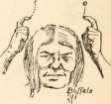
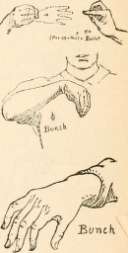
Bl/ruH
SIGN TALK
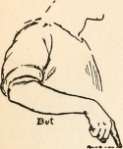


But, Except, Save, or Unless (Of all one pulled back). Sign All, with right swung to left; then sign One, with left at left side, and pull it to right side between forefinger and thumb of right.
But. Sign All Go, One, Sits.
But (One drawn back). Point right G down, forward and to right; hold it a second, then jerk it back four or five inches. (Hadley.) Fr. mais; Ger. aber.
Butte. See Hill.
Buy. Sign Money and Trade, making it clear who gives the money.
Buy or Sell i.e., Market. Tap three times on side of left G index with side of right G index. Compare, All the time, Peas, and While. See Sell. Fr. acheter; Ger. kaufen.
By. See Beside.
By and By (After a little time). Hold the pinched index and thumb of each hand as in Time, but half an inch apart. Or sign Time afterward. Compare Sometime.
Fr. plus tard; (C) Ger. spater.

Cache. See Hide.
Call, Attention! Say! Strike the palm of the open left hand with the tips of right fingers, then swing right G a little toward the person.
Fr. diles done; Ger. horen Siel
SIGN TALK
35
Called or Named. Lay the back of the crooked right G on lips, pointing to front and left, its tip pressed against the thumb, which is nearly straight; then move the hand upward and forward in a curve, straightening out the index finally with a snap, pointing toward the person or thing. Compare Talk in which the action is repeated. See also Name. Fr. appele; Ger. genannt.
Camera. Sign Picture and See. Compare Photograph.
Camp (Set up the lodge). Sign Teepee, holding the hands face high; drop the hands together for a foot with energy.
Fr. le camp; Ger. das Lager.
Camp-fire. Hold left hand flat, palm down, fingers a little spread; then lay right hand fingers similarly held across at right angles, to indicate the wood laid ready, and add the sign for Fire. (Sheeaka.) Not a true Indian sign, but sufficiently descriptive for the Chey-ennes to understand it.
Fr. lefeu de camp; Ger. das Lagerfeuer.
Camp-fire Girls. Sign Camp-fire, then raise the right index in a spiral for Smoke.
Camp-fire man are you? Give the signs Question, you, camp-fire, and man or briefly make the Camp-fire sign and look inquiringly.
Fr. Etes vous membre du Camp-fire Club; Ger. Sind Sie ein Mitglied des Lagerfeuer Klubs?

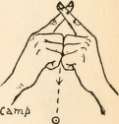
(TM •*!*•"<•)'
iCMnHfo-l

SIGN TALK

Can, Able, or Power. Hold both S hands in front, elbows at sides, thumbs up; drop the hands for six inches with a jerk. (Sheeaka and the Blackfeet.) Sometimes use only one hand. The Cheyennes sign Own, Strong, Medicine.
Fr. pouvoir; Ger. konnen.
Candid (True, clear as day and good). Sign True, Day, and Good. (C)
Fr. sincere; Ger. aufrichtig.
Candle. Hold up left G finger and with right hand sign Fire on its tip, then indicate length on left arm. Fr. la bougie; Ger. die Kerze.
Candy-stick. Sign Sugar; then on left G index held
upright, show stripes. (C)
Fr. le bonbon; Ger. das Zuckerwerk.
Cannon. Sign Gun and Big.
Fr. le canon; Ger. die Kanone.
Cannot, or Unable, Fail, Failure (The arrow that failed to stick). Hold the flat left hand out in front, thumb edge up; strike the palm of it with the forefinger of the right G hand, which then at once rebounds and is thrown forward and down to rest on its back.
Fr. ne pas pouvoir, incapable; Ger. nicht konnen, unfahig.
Canoe. Sign Boat and Paddle,
SIGN TALK
37
Canoe of birch bark. Push forward compressed right, back down, to represent the curved prow, then add Paddle.
Fr. la pirogue, le canot; Ger. das Kanu, der Rinden-kahn.
Canyon (Between hills). Hold up the fists, palms toward each other, about six inches apart, face high; then indicate Go between; that is, hold the left unchanged but thrust forward the flat right hand, palm to left. (Blackfoot.) Compare Between.
Fr. le canyon, le grand ravin; Ger. die Schlucht.
Cards. Hold imaginary cards in left and deal with right hand.
Fr. les cartes; Ger. die Karten.
Caribou. Sign Deer, High, and lay the flat right hand on forehead so the fingers slightly spread point forward, showing the brow shovel. (Blackfoot.) Sometimes omit High.
Fr. le renne, le caribou; Ger. das Karibu.
Carriage, or Covered Wagon. Sign Wagon, then raise the hands, palms down, flat, but bent at an angle, up above the head, and move forward about two feet to represent the carriage top.
Carriage or Buggy. Sign Wagon, Small, and sometimes add Black.
Fr. la voiture; Ger. der Wagen.
Carry or Pack. Both closed hands held opposite the temple as if holding the tump line, the shoulders slightly forward as though bearing a pack. Fr. porter; Ger. tragen.
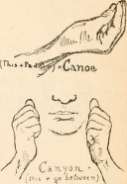
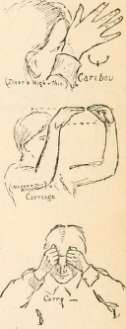
SIGN TALK

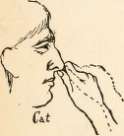
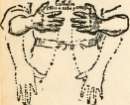
Carry in the hand. With one hand make as though carrying a basket by the handle.
Cars. See Railroad train.
Cartridge. Hold right G hand, back up, in front of body, index horizontal and pointing to front, thumb pressed against side of index, with the thumb tip just back of second joint; add Shoot. See Ammunition.
Fr. la cartouche; Ger. die Patrone, (artill) die Kar-tusche.
Cat (Flattened or turned-up nose). Lay A hand on nose, rotating a little out and up. (C) Sign Nose, Short, Dog.
Fr. le chat; Ger. die Katze.
Catch. Same as Get but action quicker. See Get. Fr. attraper; Ger.fangen.
Catholic. Indicate gown by sweeping the 5 hands down over the sides and outward; then add Black. Sometimes make the sign of the Cross. Fr. catholique; Ger. katholisch.
Cattle. Sign Buffalo and Spotted. (Blackfoot.) Compare Buffalo. Or, sign Buffalo and Whiteman. Fr. les bestiaux; Ger. das Vieh.
Caution. See Warning.
Cavalry. Soldier and Ride.
Fr. la cavalerie; Ger. die Kavallerie.
SIGN TALK
39
Centre. With thumbs and index fingers of L hands make a horizontal circle; then, keeping the left unchanged, indicate centre with right G finger. Sometimes draw a horizontal circle with right G, then drop same down into its centre.
Fr. le centre; Ger. die Mitte.
Certain. Sign 7, Know, Good. Or use True. Fr. certain; Ger. sicker.
Challenge, Defy, or Dare. Spring the middle finger with a vigorous snap toward the person, the other fingers closed; hand held face high, back up. A European sign given by Butler. Compare There and Defiance. Fr. defier; Ger. herausfordern.
Chance. See Luck.
Character (Shape of heart). Lay right C hand on heart, draw it out, that is, forward, a little and with both A hands outline a human figure. (D) Sign Heart, Good, Bad. (Blackfoot.)
Fr. le caractere; Ger. der Charakter.
Charge (Military, against others). Swing both fists from right shoulder forward and a little down in an up curve, away, rising a little, at the same time springing them open.
Fr. la charge (contre les autres); Ger. die Attache, der Angriff (gegen andere).
Charge (Military, against us). Similar but reversed, springing the hands open toward one's face.
Fr. la charge (contre nous}; Ger. die Attache (gegen uns}.




.
\ /xr^v'-A ^rr
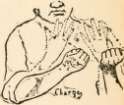
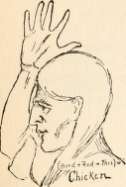
. -i '• •
er.
40 SIGN TALK
Chase. See Follow.
Cherries (Choke). Sign, Tree, Pick, and Pound. (Blackfoot.) See Berry.
Fr. les cerises; Ger. die Kirschen.
Cheyenne. See Indian.
Chicken. Sign Bird, then Red and with 5 hand on crown show Comb. (C) Or sign Bird and Whiteman. F r . fe poulet; Ger. das Huhn.
Chief (People with one man rising above them). Hold up left 5 hand, palm to right, pass index of right G hand at several inches above left. (Scott.) The Cheyennes omit left hand; they shoot the right G up over and much down in a long sweep, finishing lower than it began.
Fr. le commandant; Ger. der Hauptling.
Child or Offspring. Compressed right hand, points up, swung well out in front and dropped a foot to the height of the child. Compare Young. Fr. I'enfant; Ger. das Kind.
,', f \ ,4 Children (Springing up). Hold out both hands, palms
""""• (i ~
up, very low, fingers pointing up and scarcely spread; alternately swing them up and down for six inches. Compare Grass, in which they are held low and are spread widely; also Bushes.
Fr. les enfants; Ger. die Kinder.
Choose, Make choice, or Select. Hold right G shoulder high, back up, a foot in front of the breast, swing it in a


SIGN TALK
41
circle with a succession of little bounds or up curves, as though pointing at many different objects in succession, the head turned to follow always; then finish by throwing the G finger forward in a curve; or, in some cases, finish by picking up the imaginary object selected, using index and thumb for this. Compare Find, Hunting, and Look.
Fr. choisir; Ger. wahlen.
Chop. Use the flat right hand, little finger down, as an axe, chopping first from right, then from left, once on each side. Sometimes do this on back of left hand, which stands for the log. Compare Free, which is two or three cuts on right side only.
Fr. couper, trancher; Ger. hauen, hacken.
Christmas (The day of the shining tree). Sign Tree, then hold hand with fingers spread and crooked, palm down, level of face. Lower it six inches in short, quick zigzags to suggest glittering or shimmering. (W. C-Roe.) In Snow the hand is lowered in long zigzags for about two feet. See Shimmer. Or sign Middle, Winter, Tree, and Hanging; for the last, hold the curved 5 hands, backs up, at level of the eyes; jerk them a little apart. (R. B.)
Fr. le Noel; Ger. Weihnachten.
Church (Steeple house). Cross clasp the fingers so the tips are within, then raise both index fingers to form the steeple. (Pop.)
Church. Sign Medicine, Talk, House. Fr. I'eglise; Ger. die Kirche.

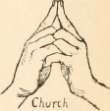

Cigarette. Sign Tobacco; then lay G fingers side by side pointing opposite ways; roll one about the other. Sometimes omit Tobacco; sometimes give Cigar (2nd sign) and Little.
Fr. la cigarette; Ger. die Zigarette.
Cigar (2). Sign Cigarette, Black, andSmoking. Sometimes hold right G at corner of mouth, pointing forward. Cigar and Cigarette are recent signs and changing rapidly.
Fr. le cigare; Ger. die Zigarre.
City (Big town). Make sign for Town, then add sign for Big. Or omit Big but swing the hands far apart. Fr. la mile; Ger. die Stadt.
Cities. Many are indicated by their initial letter enhanced with twisting motion. (D) For some we may use their nickname but this is merely a suggestion.
Boston (The Hub). Sign for City and Centre.
Chicago (Windy City). Sign for City and Wind. The Cheyennes call it Big Lake City.
Kansas City (Buffalo Head City). Sign Bujfalo Head and point up high to the wall. (Cheyenne.)
London. Sign City, Chief, and Red Coats.
New York (Knickerbocker City). Sign for City and trousers cut off below the knee; i.e., draw flat of hand down over thigh then below knee and stop, turning edge of hand in. Or sign Big Island City. (Blackfoot.)
Ottawa. Sign City, Chief, and Capotes.
Philadelphia (Quaker City). Sign City, then make sign for broad hat with lim curled up by drawing both index fingers across mid-brow, level in front, then twisting them up at the place of the rim. name, just Big City, nothing distinctive." (Blackfoot.)
Pittsburg (Smoky City). Sign for City and Smoky. Rome (Eternal City). Sign City and Forever. Washington. Sign Father, Chief, Sits. (Cheyenne.)
Clean-handed or Innocent (Great Spirit see no blood on these hands). Lift hands over shoulder, palms up higher than head and add Blood, No. (C) Or, sign Work, Bad, No.
Fr. innocent', Ger. unschuldig.
Clear (Clear Sky). Sign Clouds, then swing the hands wide apart, finishing with palms up at arm's length, up high. Or, sign Clouds, Wiped out. (Blackfoot.)
Clever. See Cunning.
Close, Near, Nearly, Soon, Early, About, or Almost (Draw near). Bring the flat curved right hand, back to right, well out in front of body, about height of shoulder; draw the hand in toward the body and slightly downward. Compare Far. See also Soon. Fr. pres, presque; Ger. nahe, beinahe.

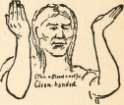

Clothes. See Coat.
SIGN TALK


"Sr;
'•} *
. ,,11, !„><= jri \_Mju"'«'«

Coff,
fe
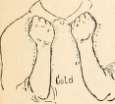

Clouds (Rolling). Rotate the flat hands over each other from in front of the face, to over the head.
Clouds (Rain). Look upward, swing the flat hands at arm's length, palms down over the head; then add Rain. Fr. les nuages; Ger. die Wolken.
Coal. Sign Hard, Fire, and Good. Fr. le charbon; Ger. die Kohle.
Coat or Clothes. Hold the L hands near the breast, palms in; swing them down to the waist. Fr. Vhabit; Ger. der Rock.
Coffee (Grinding coffee in mill). A few inches over the flat left hand, back down, move the right A as though turning the crank of a coffee mill. Or, sign Black Drink. Compare Tobacco.
Fr. le cafe; Ger. der Kafee.
Coin. Close hollow right over hollowed left and shake as tho jingling coin. (Sheeaka; not Indian, but now understood.) See Dollar.
Fr. la piece d'argent; Ger. die Munze.
Cold (Shivering). Bring the fists in front of and close to body, height of shoulder, elbows at sides, shoulders drawn in, and shiver. See Winter. Compare Blanket. Yr.froid; Ger. kalt.
} '-/ Color. With the finger tips of right hand (thumb
y crooked under) rub circularly on the palm of left hand as though rubbing color. Often add Same or Equal, to make more clear.
Fr. la couleur; Ger. die Farbe.
Color— Continued
Black. Sign Color and touch the hair or eyebrow. Fr. noir; Ger. schwarz.
Blue. Sign Sun with left hand and then draw the right G finger around it to mean color of sky around the sun. (Sheeaka). Or, sign Color and Sky. Fr. bleu; Ger. blau.
Brown. Sign Color and Deer. Fr. brun; Ger. braun.
Gray. Sign Color, Little, and White. Fr. gris; Ger. grau.
Green. Sign Color and Grass. Fr. vert; Ger. grun.
Red (Cheek color). Sign Color and lightly brush the right finger tips over the cheek, points to right. Fr. rouge; Ger. rot.
White. Sign Color and rub thumb nail of left A hand with tip of right G finger; i. e., nail color, white in Indians.
Fr. blanc; Ger. weiss.
Yellow. Sign Color and point to any yellow object, such as a straw or dead grass. Or sign Color, Grass, and Dead.
Fr.jaune; Ger. gelb.
For other colors, touch or indicate some object of the tint meant.
SIGN TALK
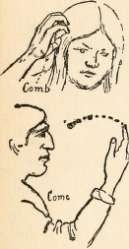

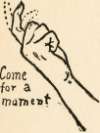
Comb. With all fingers of right 5 hand hooked, comb the right side of the head and down as far as the breast two or three times. Compare Woman. Fr. le peigne; Ger. der Kamm.
Combat. See Battle.
'
Come. Carry right G hand, back out, fingers up, in a graceful sweep from arm's length to within a foot of one's face. Many use the flat hand swung down and to you, palm under and toward you. Railroad men use the whole arm, swinging it across the body at an angle of 45 degrees, so as to be seen in a dim light. Fr. venez; Ger. kommen Sie.
Come back. Hold flat left, back forward, near breast; swing right ditto pointed up from arm's length in against back of left. See Arrive here. Fr. revenez; Ger. kommen Sie zuruck.
Come between or Intervene. Hold out left hand flat, back out, at arm's length and pass flat right, thumb up, between left and body.
Fr. s'interposer, intervenir; Ger. dazwischen kommen.
Come gently. See Easy.
Come for a moment. Right hand held forward and up, fingers closed except index, with which beckon by crooking and straightening, the hand not moved. (Pop.) White sign, now fully adopted by the Chey-ennes.
, Fr. venez une seconde; Ger. kommen Sie einen, Augenblick her.
SIGN TALK
47
Come into view or Appear. Hold out flat left hand, back forward, thrust right G index up, farther off, under and behind, until it appears above. Fr. paraitre; Ger. erscheinen.
Comfort (See how smooth or fat). Draw flat right hand, palm in, down breast, then off and up in curve forward, palm up. (Sheeaka.) Compare Confess. Sometimes use Glad. (Blackfoot.)
Fr. le bien-etre; Ger. die Behaglichkeit.
Comfortable. Alternately rub left palm over back of / right hand, then right over left back, always palm up; / J then swing both forward. (Sheeaka. Probably from Deaf.)
Fr. confortable; Ger. gemutlich.
Coming. Hold out the flat right, palm to you and pointing nearly up; draw it to you in little jerks. Fr. venant; Ger. kommend.
Coming man. See Rising man. Commence. See Begin.
Compass points.
North — Wind cold there.
Fr. le nord; Ger. der Norden. East — Sunrise there.
Fr. Vest; Ger. der Osten. South — Wind warm there.
Fr. le sud; Ger. der Suden. West — Sunset there.
Fr. I'ouest; Ger. der Westen.
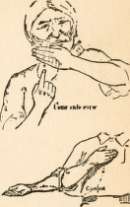

SIGN TALK
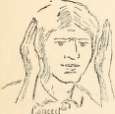

Complete. See Done.
Comparative, etc., of Adjectives.
For Positive, give first the adjective then swing the flat right hand out a little, level, palm up. (Sheeaka.) For Comparative, give first the adjective then raise the right G hand to the height of the chin, pointing up. (Sheeaka.) See More, and sometimes use Ahead or Above after the adjective.
Fr. le comparatif; Ger. der Komparativ. For Superlative, give first the adjective then add Strong and Ahead or Very much.
Fr. le superlatif; Ger. der Superlativ.
Conceal. See Hide.
Conceit (Swelled Head). Hold hands open and curved, one on each side of the head, two or three inches away. A whiteman's sign, but quite well known now to the younger generation of Indians.
If in unbelievable degree, stretch the right hand at full length sidewise, and work the first ringer as though scratching the ear which is supposed to be just above the hand. (Pop.)
Conceit. Sign He, Think, Strong.
Fr. la vanite, la presomption; Ger. die Einbildung, der Dunkel.
Conduct. Same as Way.
Confess (Show the heart). Lay points of both compressed hands on centre of breast, then spring them away, out and aside, turning them flat and palms up. Sometimes but one hand is used. I am inclined to
SIGN TALK
49
think that this should be simply Heart and Behold, although none of my Indians made it that way. Sometimes sign You, Tell, True. Fr. confesser; Ger. gestehen.
Congress. Sign Whiteman, Chief, Council (No. 2). Fr. le Congres; Ger. der Kongresz.
Connivance (Wink, that is, close one eye). This ancient sign assumes that the person who should see, closes the eye next his accomplice. (Pop. Also Cheyenne.)
Fr. la connivence; Ger. die Konnivenz, das (strafbare) Einverstandnis.
Consider, Ponder, or Weigh (Wisdom looking on the ground). Sign Wolf (i. e., wisdom, analogous with our word "foxy"), then turn downward the points of the two fingers representing the wolf ears, back of hand near the eyes and moving the hand from right to left as in surveying the ground. (Scott.)
Consider. Hold the right "4" hand near the heart, pointing to left, rotate a little back and forth. (Black-foot). The Cheyennes use V hand, which makes it the same as //. See Because.
Fr. considerer; Ger. erwagen.
Constable. See Policeman. Contempt. See Scorn.
Contented. To make contented, Satisfied. Use Glad or Sit, Good. (Blackfoot.)
Fr. content; Ger. zufrieden.
Continue. Sign Go and Long Time. (Blackfoot.) Fr. continuer; Ger.fortsetzen.
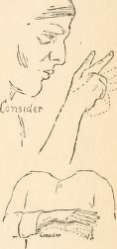
.•f-X , '•' ' ' - -^|
v ' ' **•*•'*-"" "it 1
•Unj.JcF '•'••/}.




SO SIGN TALK
Conversation. See Discussion, Speech, and Talk.
Cook (In the abstract). See Make and Food. Fr. faire cuire, cuisiner; Ger. kochen.
Cook (By boiling). With both L hands make a horizontal circle, then holding left unchanged, put something into it with right and add Fire. Compare Centre and Hole.
Fr. cuire, bouillir; Ger. kochen.
Cook (By frying). Place flat right on flat left hand, palm to palm, then flip the right like a pancake, turning it palm up as it drops on the left.
Cook (By broiling). As in the above Frying, but leave out the left hand entirely.
Fr. griller; Ger. braten, rb'sten.
Cook (noun). Sign Man, Makes, Food. Fr. le cuisinier; Ger. der Koch.
Coon. See Raccoon.
Corn (Shelling the corn). Hold out the left A hand, thumb straight and resting on index finger; place the ball of the thumb of right A hand on back of left thumb near its base; twist the right hand by wrist action to the right and downward until the right thumb slips off with a snap against the right index. Repeat once or twice. Fr. le mats; Ger. der tiirkische Weizen, der Mais.
Corral or Fenced Field or Pasture (Area embraced or held). Interlock the fingers, hold arms curved in
SIGN TALK
51
front, horizontal; then add Enclosure, i. e., swing the hands apart and draw back each in a half circle till their heels meet near you.
Fr. le corral; Ger. die Einzdunung.
Council (Sitting in a circle and talking). Bring the A hands, back outward, well out in front of body, a little lower than the shoulders, little fingers touching; swing them apart and toward the body so they meet close ' to it, forming a horizontal circle; palms forward; then add Discussion.
Council(2). Exactly like Across, but repeated two or three times. This is a recent sign among the Cheyennes, but is becoming popular. See Across and Law. Fr. le conseil; Ger. die Ratsversammlung.
Counsel or Advice. See Advice. Counting. See Numbers.
Count coup or Make a hit or a Strike (Striking a dead body with the coup stick). Strike the top joint of the right G index on the middle of the left G index, as the / right is swung from below up. Grand Coup sign Coup and Great.
Fr. le coup; Ger. der Treffschusz.
Country. See Land. Coup. See Count coup.
Courting (Driving or rounding up in secret). Thrust the right L hand back nearly up under flat left, held
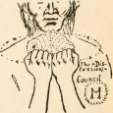




palm down, twisting the right by wrist action. Compare Sweetheart and Glitter.
Fr.faire la cour; Ger. das Courmachen, das Hofmachen.
Coward. See Fear.
Coyote. Sign Wolf and Small.
Fr. le coyote, le loup des prairies; Ger. der Pra'riewolf.
Crab. Place base of wrist of right hand, palm down, on some flat surface, thumb and little finger extended and curved (others closed) to represent claws. Then move the hand sidewise backward, waving the claws. (Scott.) Compare Spider.
Fr. le crabe; Ger. die Krabbe.
Crave. See Want.
Crayfish. Hold out the V hand level; draw it back, opening and shutting the V. Compare Dog. Fr. I'ecrevisse; Ger. der Krebs.
^ Crazy, Foolish, Mad, Demented (Brain in a whirl). Raise compressed right hand, all fingers together, tap the forehead with it and make one or two quick circles with finger tips in the air. (Sheeaka.) Tap the forehead, shake the head and point to the person. (Pop.)
Crazy. Swing the 5 hand in horizontal circles near the forehead, going with the sun. Going the reverse way always raises a laugh among Cheyennes; it both intensifies and makes the idea ridiculous. Fr. fou; Ger. verriickt.
Cree. See Indian.
SIGN TALK
53
Creek, Brook, or Rill. Sign Water, then draw right G hand, back up, held low, from opposite left side, past body to right side; finger level, pointing to left and waved sidewise. Compare River, Snake, Crooked, and Wire.
FT. le ruisseau; Ger. der Bach.
Crime or Sin. Sign Strong, Bad, Work. FT. le crime; Ger. das Verbrechen.
Crooked or Wrong. Point the right G forward and slightly down; push it slowly forward in a succession of large, horizontal zigzags, each arched a little.
Cross or Sulky. Rest the forehead low on the left hand. Or sign Heart, Bad.
FT. maussade; Ger. miirrisch.
Cross (of Christ). Hold right G upright, left G at right angles across last joint of right.
Fr. le crucifix; Ger. das Kruzifix.
Cross. See Across.
Cross the heart. With right index make a little cross over the heart. This means " I give you my word of honor.'; (Pop.)
Fr. parole d'honneur!; Ger. auf mein Ehrenwort!
Crow. Sign Bird and Black.
FT. la corneille; Ger. die Krake.
Crowded. See Few.
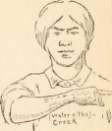

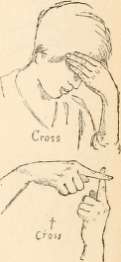
Crow Indian. See Indian.
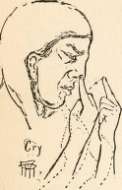

Cut-
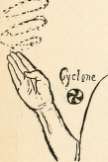
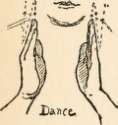
54 SIGN TALK
Crush. See Exterminate.
Cry out. See Yell.
Cry, To weep. With G forefingers near the eyes trace the courses of tears. If excessive, sign Rain from the eyes. (Blackfoot.) Compare Pity. Fr. pleurer; Ger. weinen.
Cunning, Smart, or Clever. Make the sign for Wolf and add the sign Equal. Compare Consider. Fr. ruse; Ger. schlau.
Cut. Saw the lower edge of the flat right across the palm or edge of the flat left. Fr. couper; Ger. schneiden.
Cutting up. See Meat.
Cyclone or Whirlwind. With flat right hand, back to the right and level with the right shoulder, make a spiral upward. A very small one for a little dust whirlwind, and a large violent one for a dangerous cyclone. Fr. le cyclone; Ger. der Wirbelsturm.
D
Dam. Sign for Stream or River and Hold. (Black-foot.)
Fr. la digue, I'ecluse; Ger. der Damm.
Dance (People jumping together). Bring the flat (or "5") hands in front of body about height of breast, with fingers pointing nearly up, palms toward each other
SIGN TALK
55
about six inches apart. Move the hands briskly upward and downward a few inches several times, simultaneously, mostly by elbow action. Compare People.
Dance (Drumming). Hold up one flat hand face high, back to side, thumb raised and up: jerk up and down. (C) Fr. danser; la danse; Ger. tanzen, der Tanz.
Danger (The Scout or Wolf going ahead and coming back to report danger). Right V hand, back upward, moved directly and slowly forward in front of the right shoulder and then suddenly and quickly drawn back at the same time the body is thrown back a little. (Shee-aka.)
Danger. Sign Look, Little, Afraid (No. 2). Fr. le danger; Ger. die Gefahr.
Dangerous (Of a man). Sign Strong and Bad. Fr. dangereux; Ger. gefahrlich.
Dare you. See Challenge.
Dark, Unknown, Obscure. Bring the flat hands, back outward, in front of face, right hand nearest face, left a little ahead, hands crossed, tips of fingers about opposite centre of forehead; bring the hands very slightly toward face. Compare Ashamed and Blind. Fr. obscur; Ger. dunkel.
Daughter. Sign Born and Female. Fr. la fille; Ger. die Tochter.

Ds-n.ee.

JJ.y.r
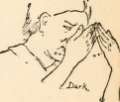

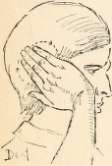

Day. See Time.
Daybreak. Sign Little, Sunrise.
Daybreak (A peep through darkness). Hold right flat hand above left flat hand and in same plane; right little finger on left index then raise the right hand a few inches higher. (C)
Fr. I'aube; Ger. der Tagesanbruch.
Dead, Death. Make the sign for Die and Sleep. (C) The Cheyennes use Die. Fr. mort; Ger. tot.
t
' Deaf (Hearing ground out). Press the palm of extended right hand slightly against right ear, and move the hand in small circle parallel to and close to the ear. Sometimes add Not.